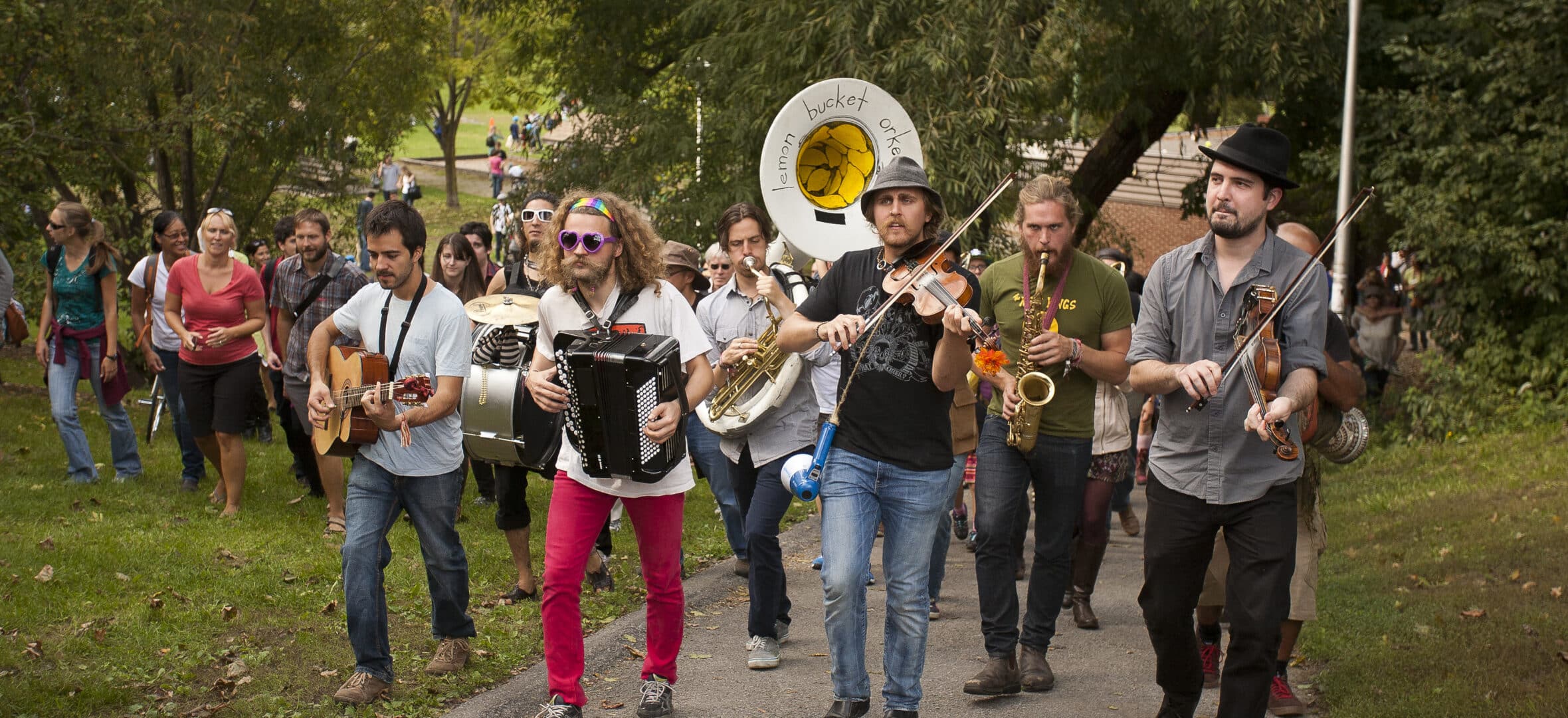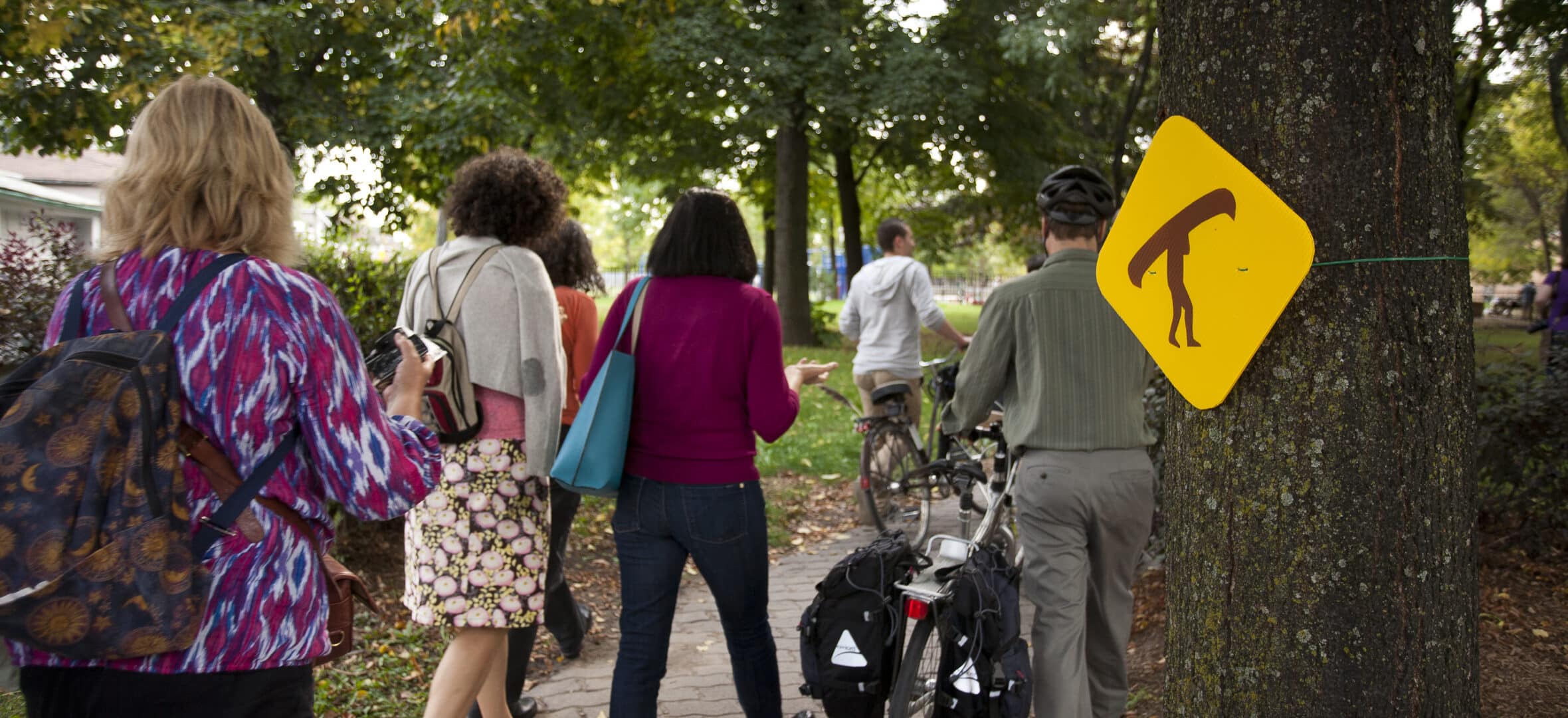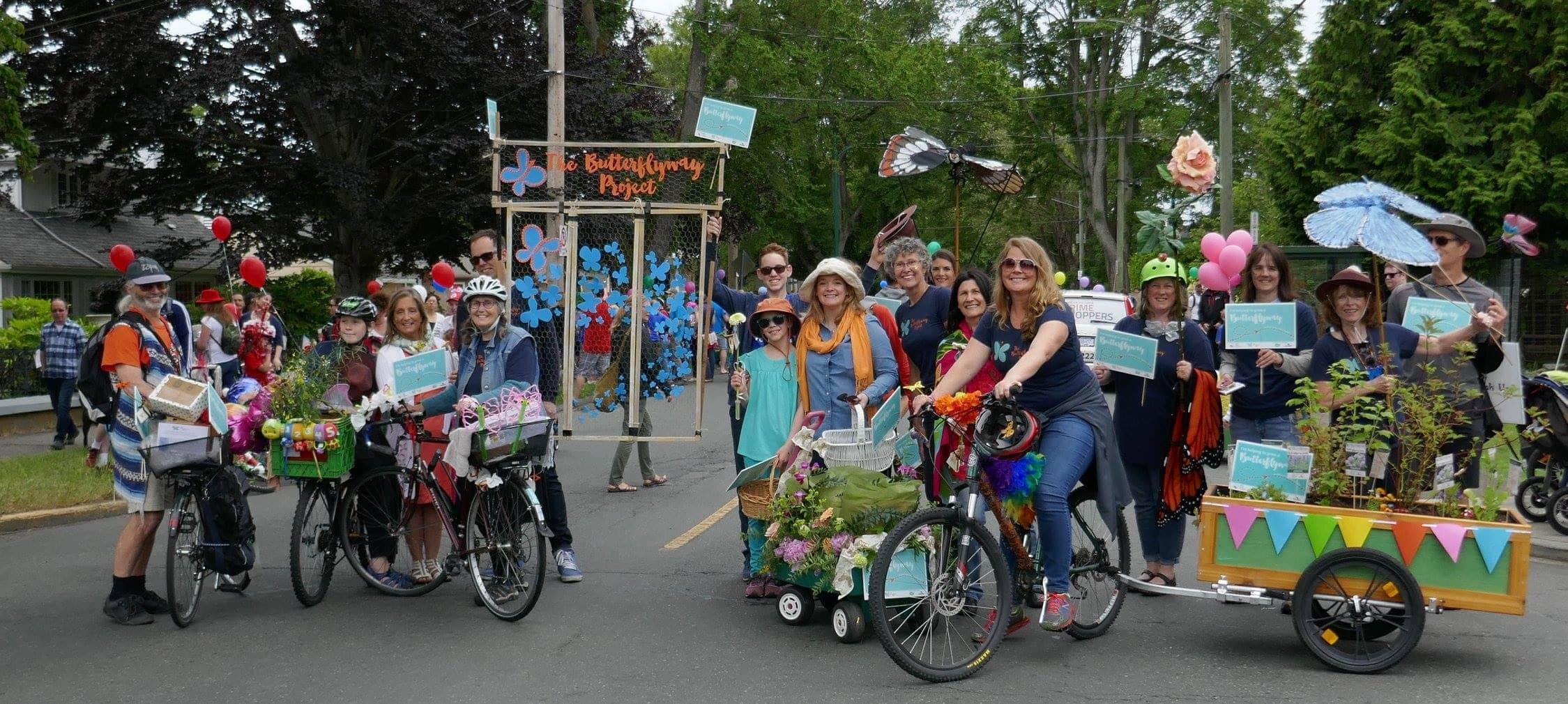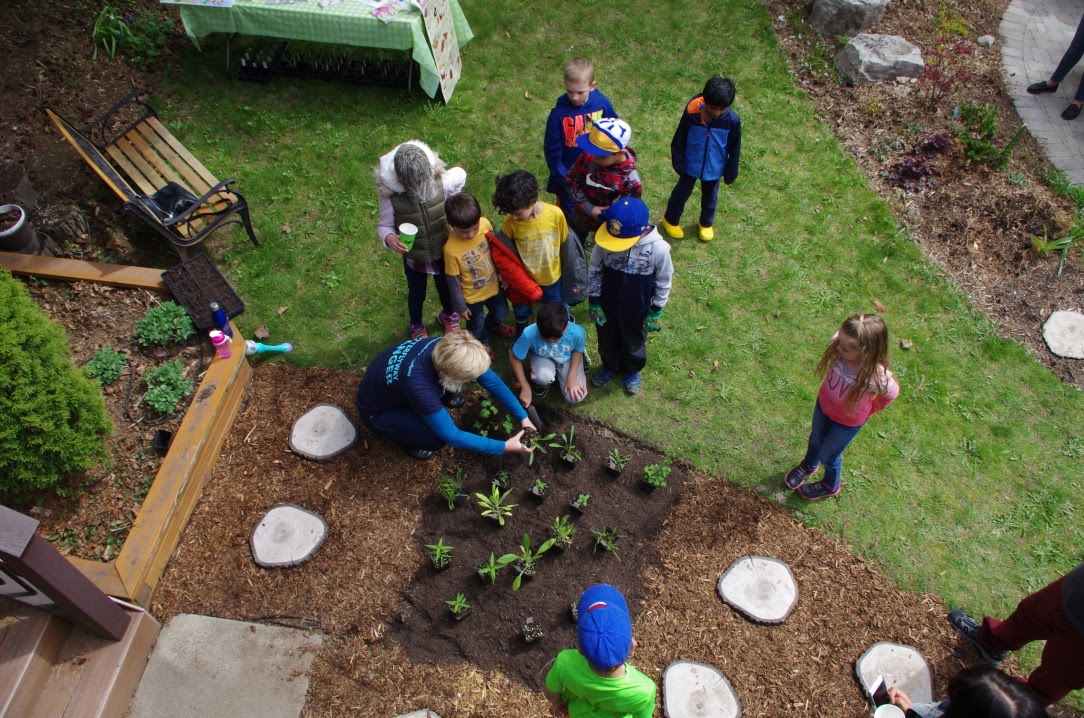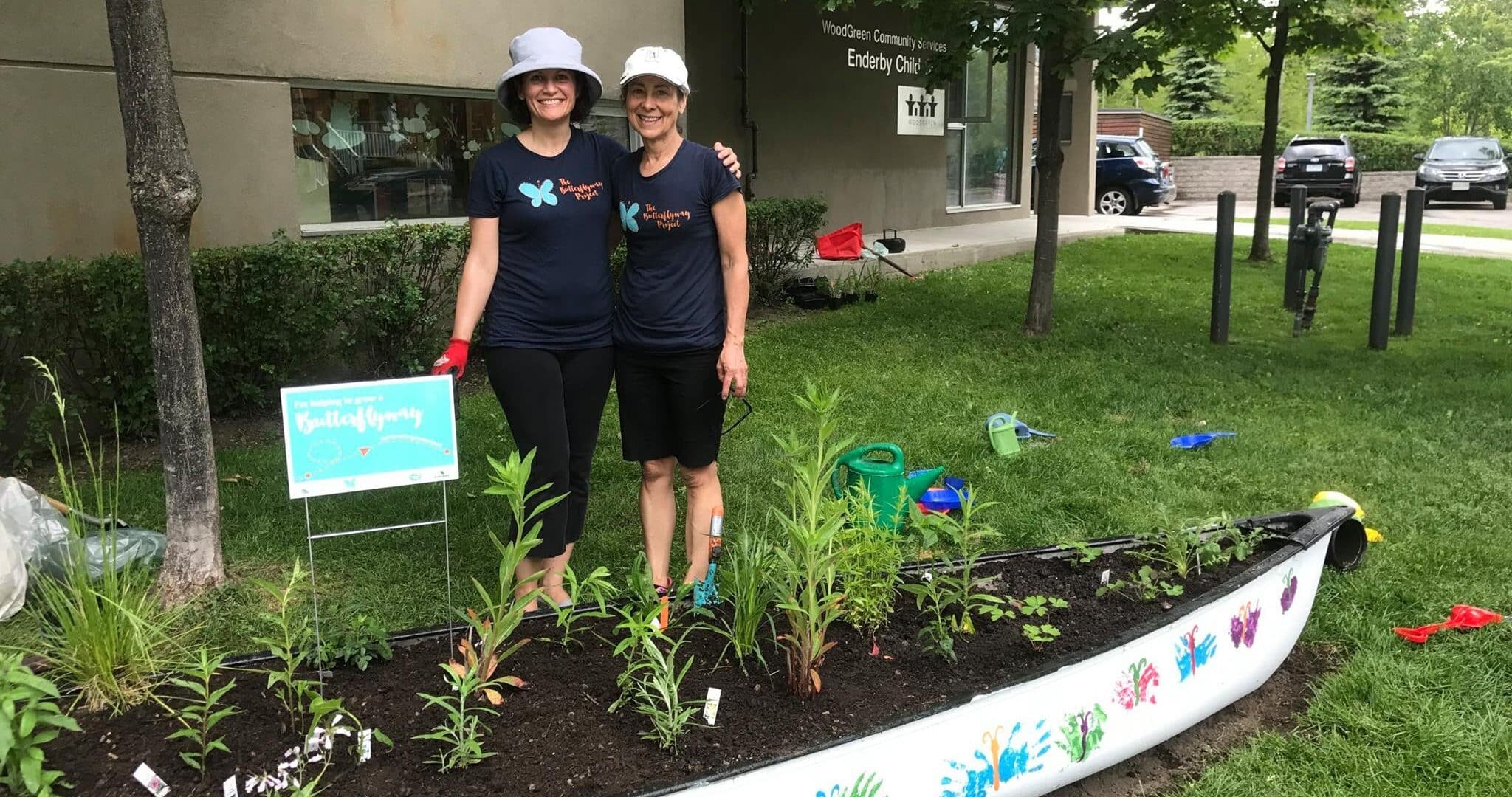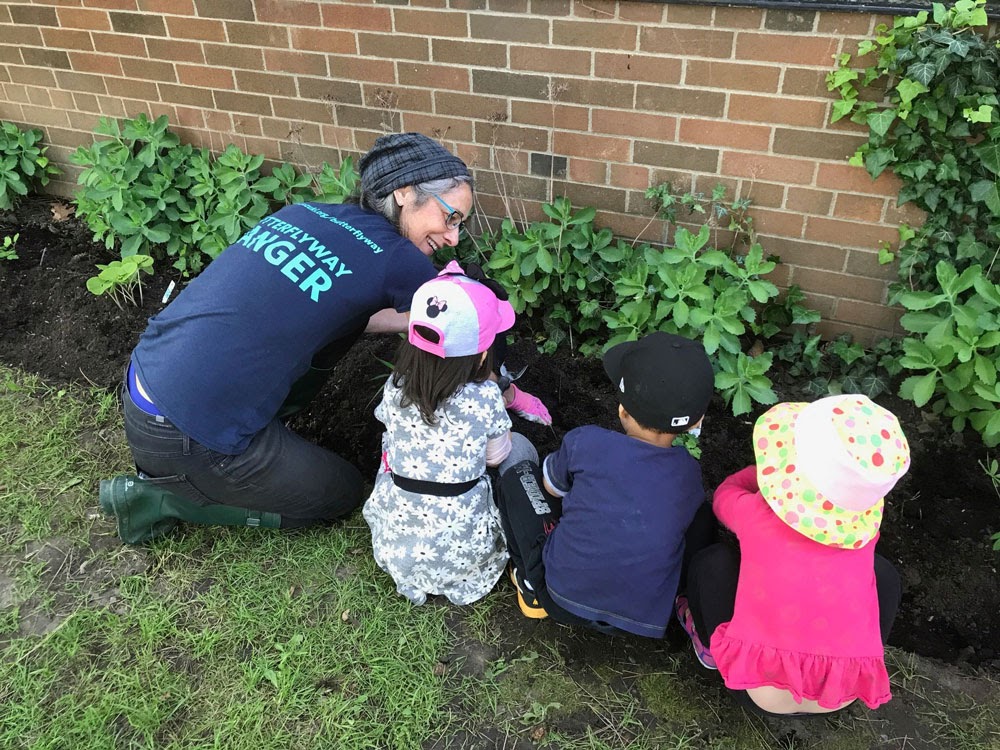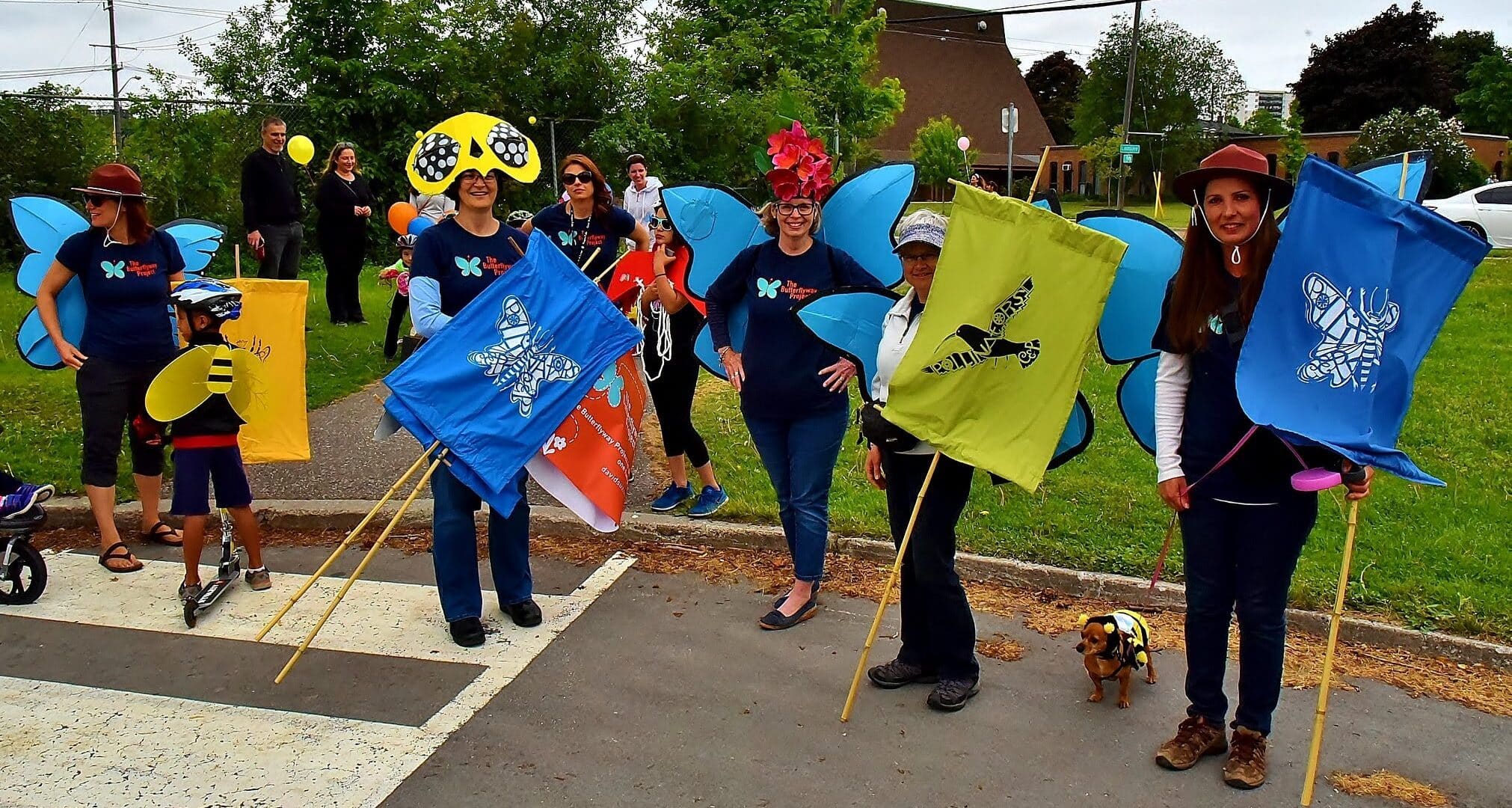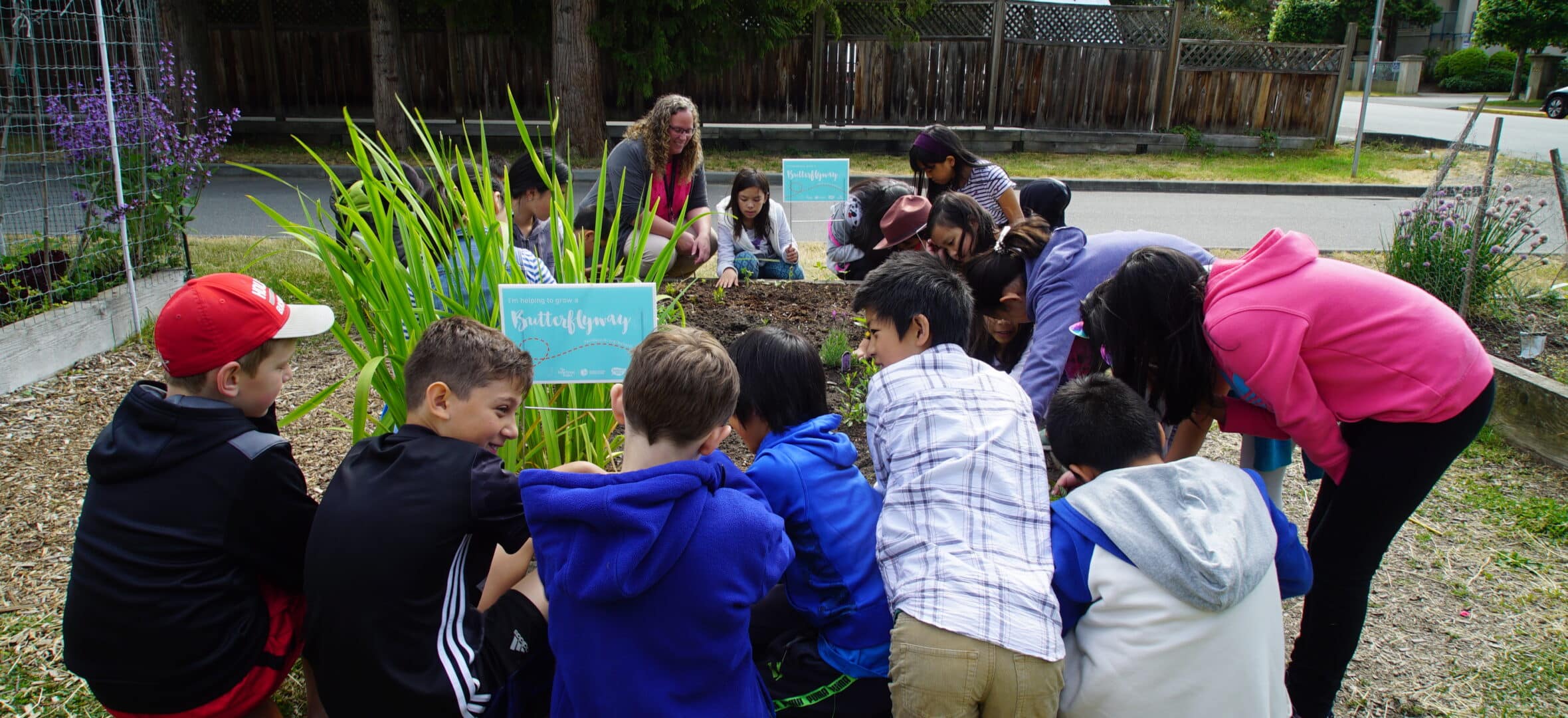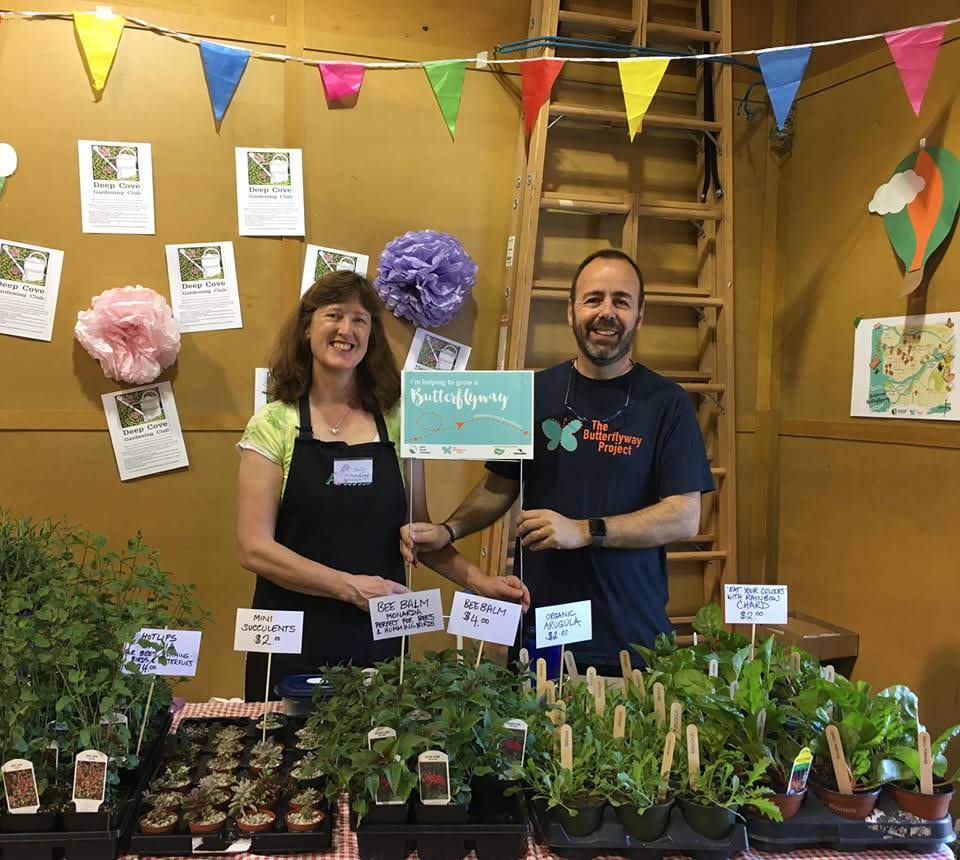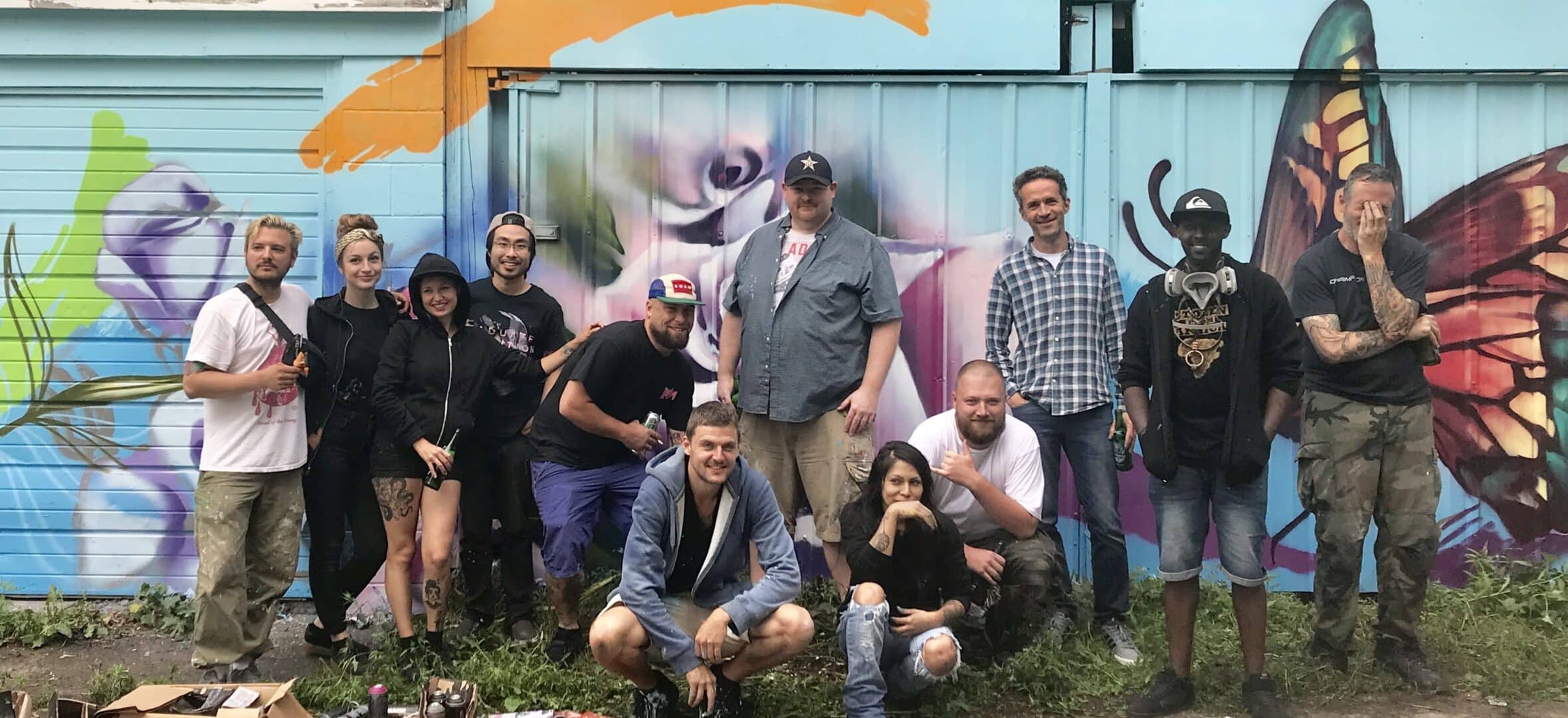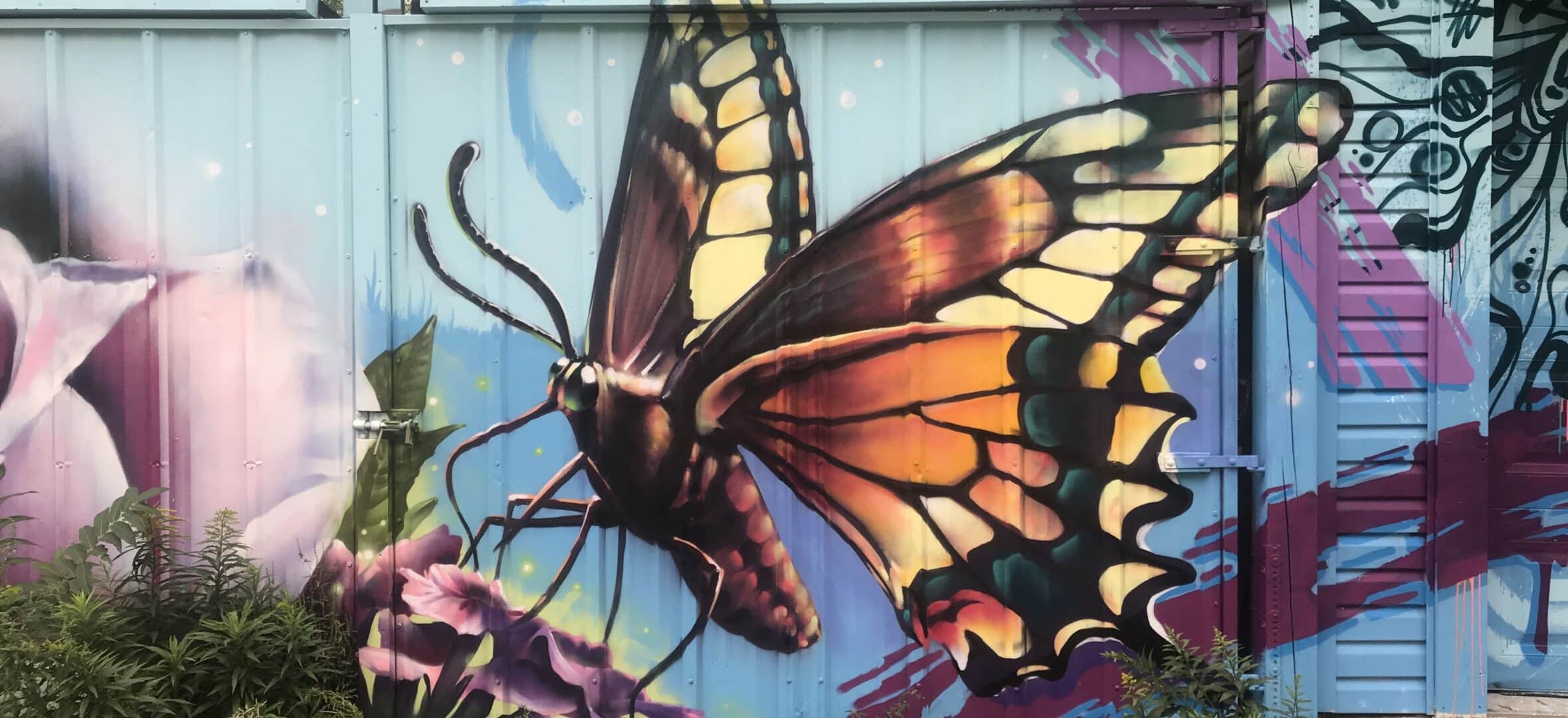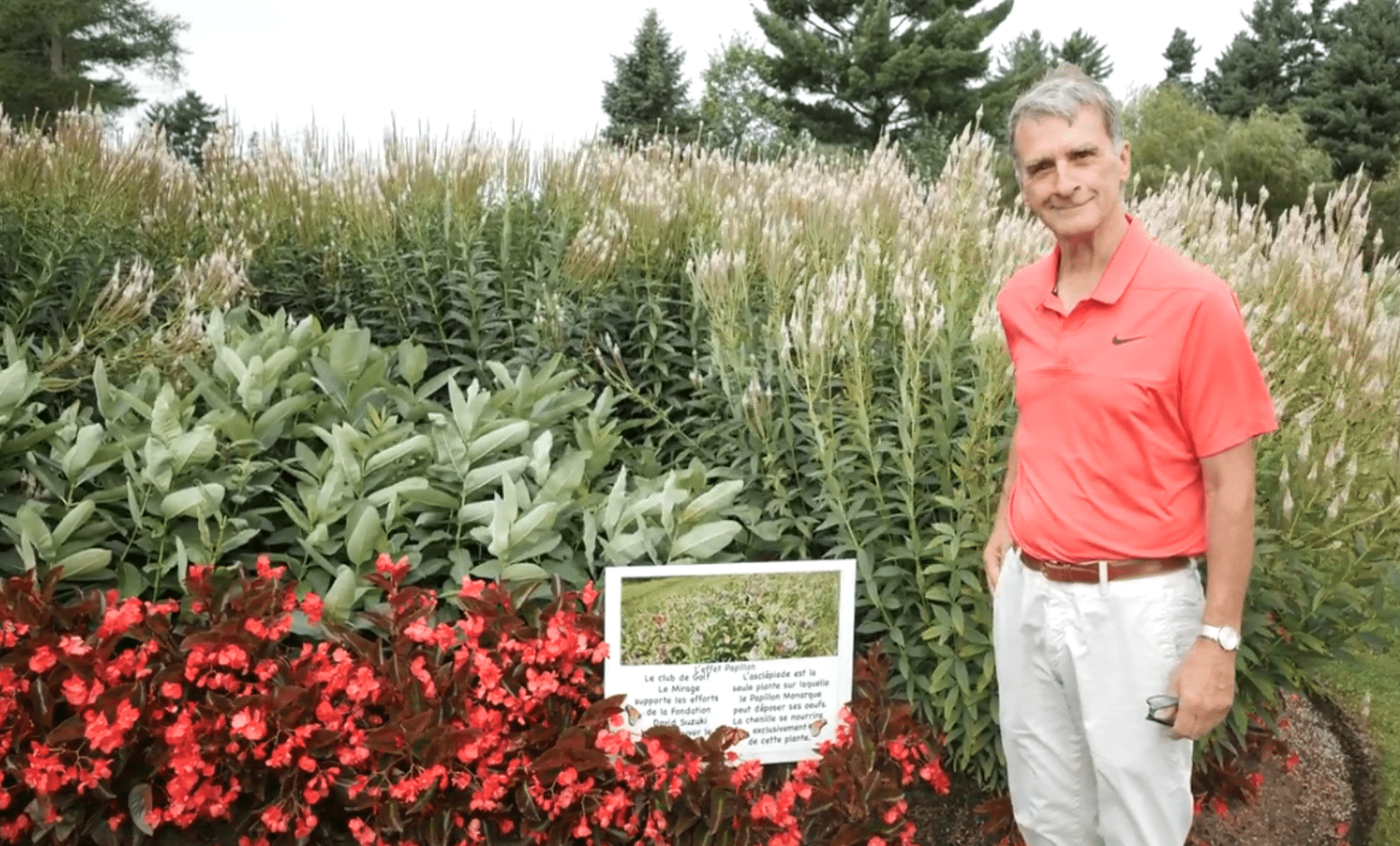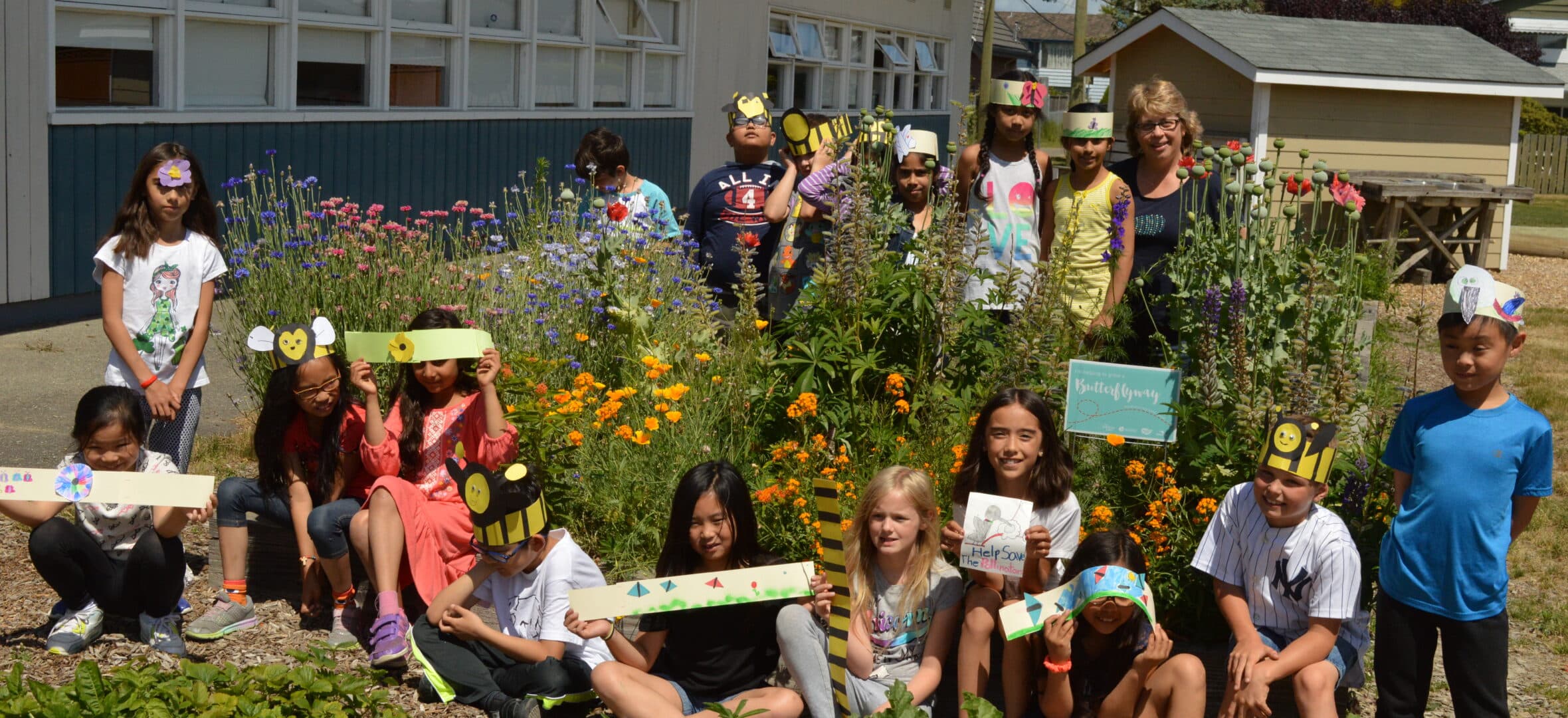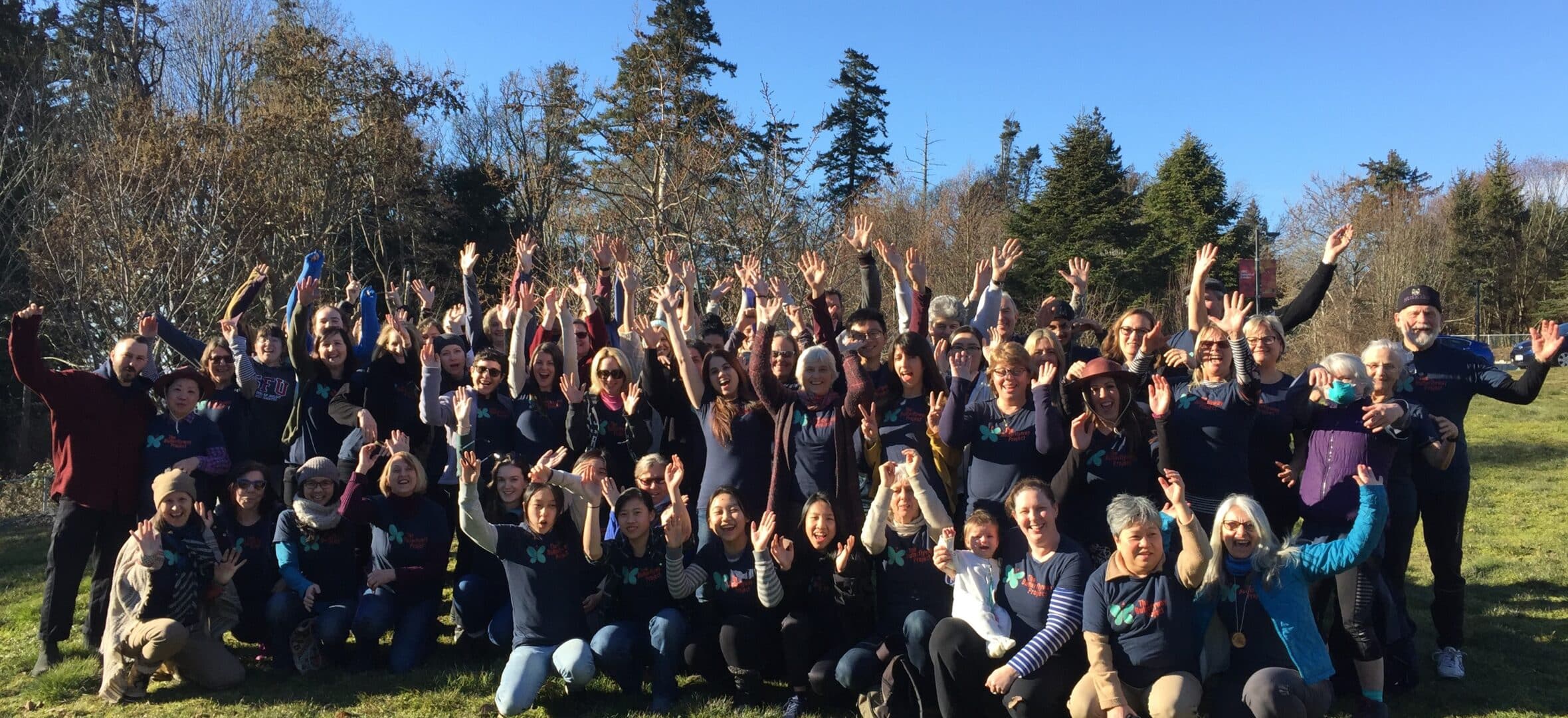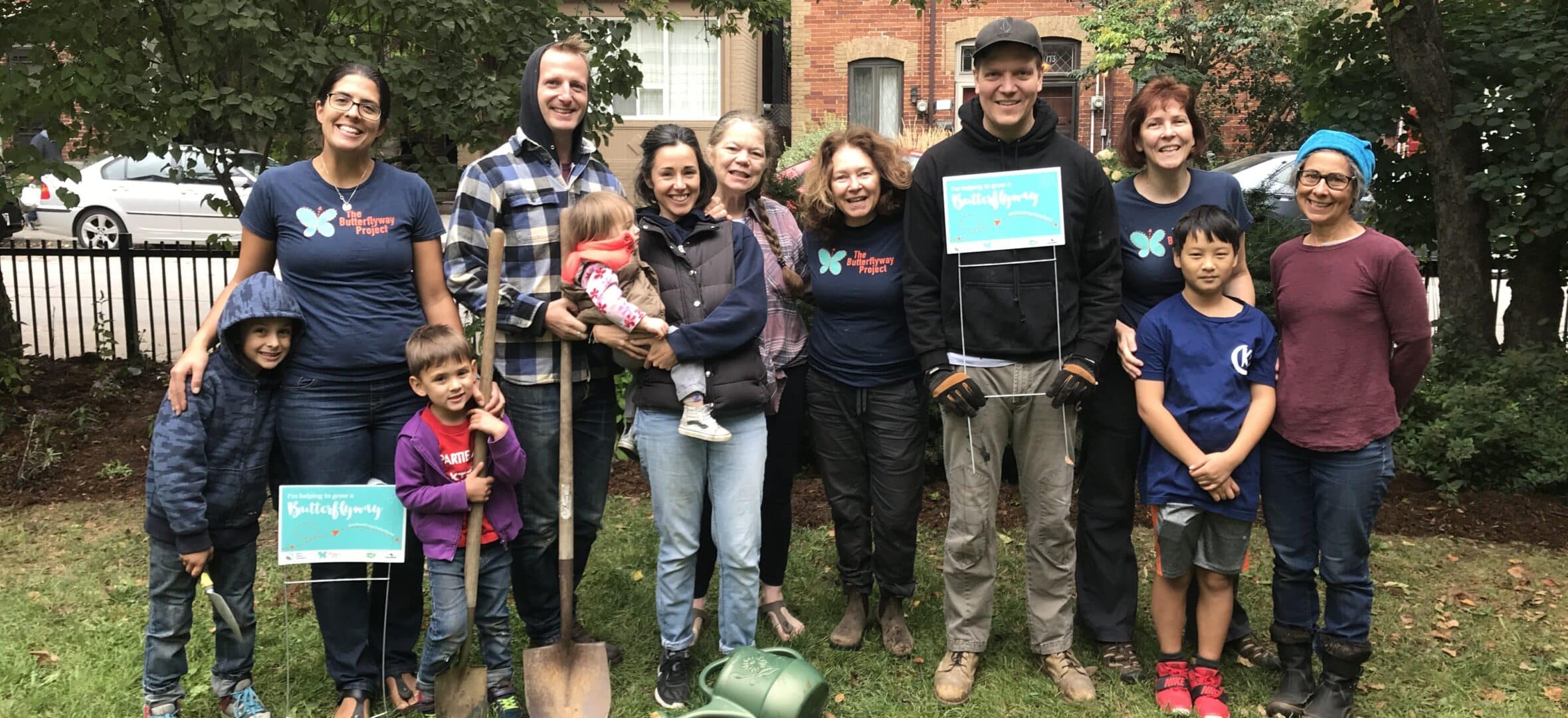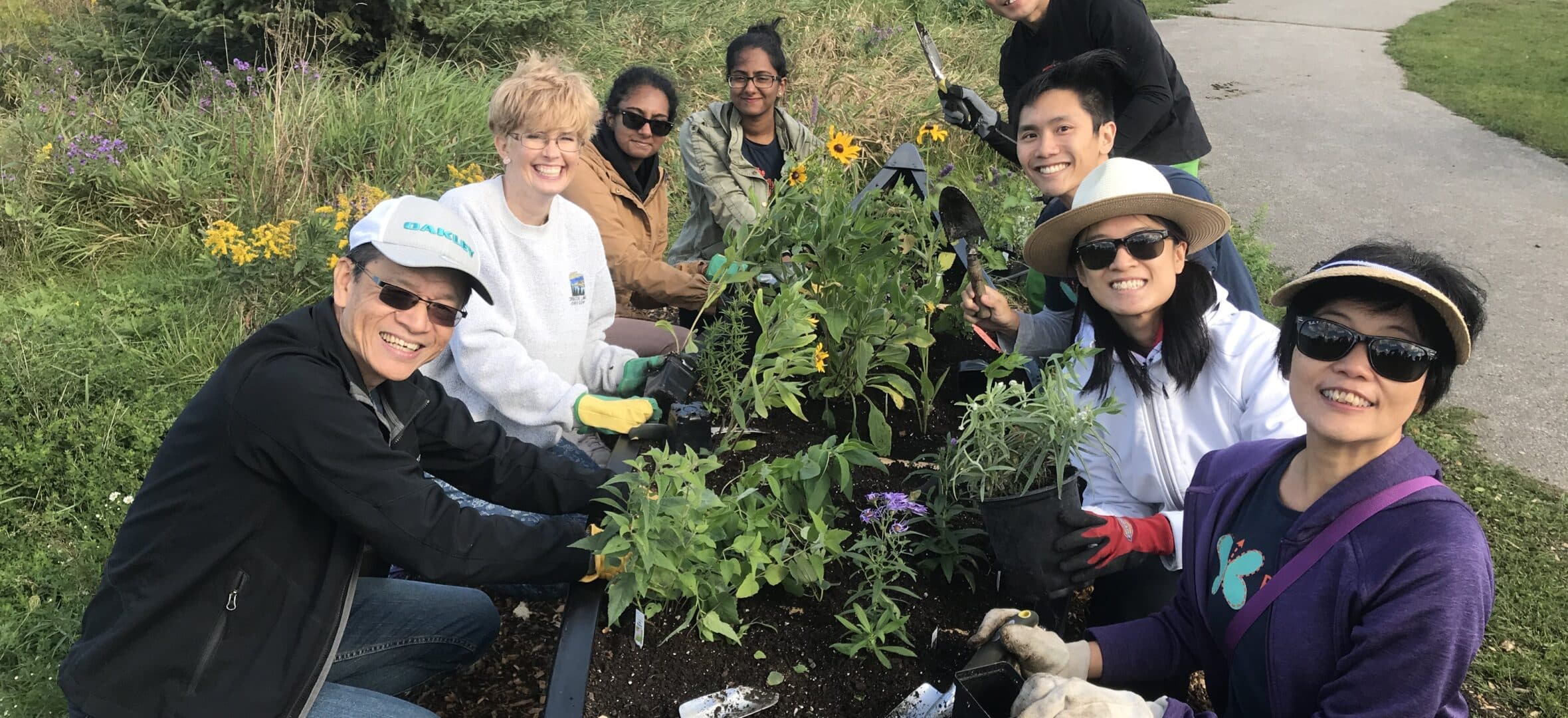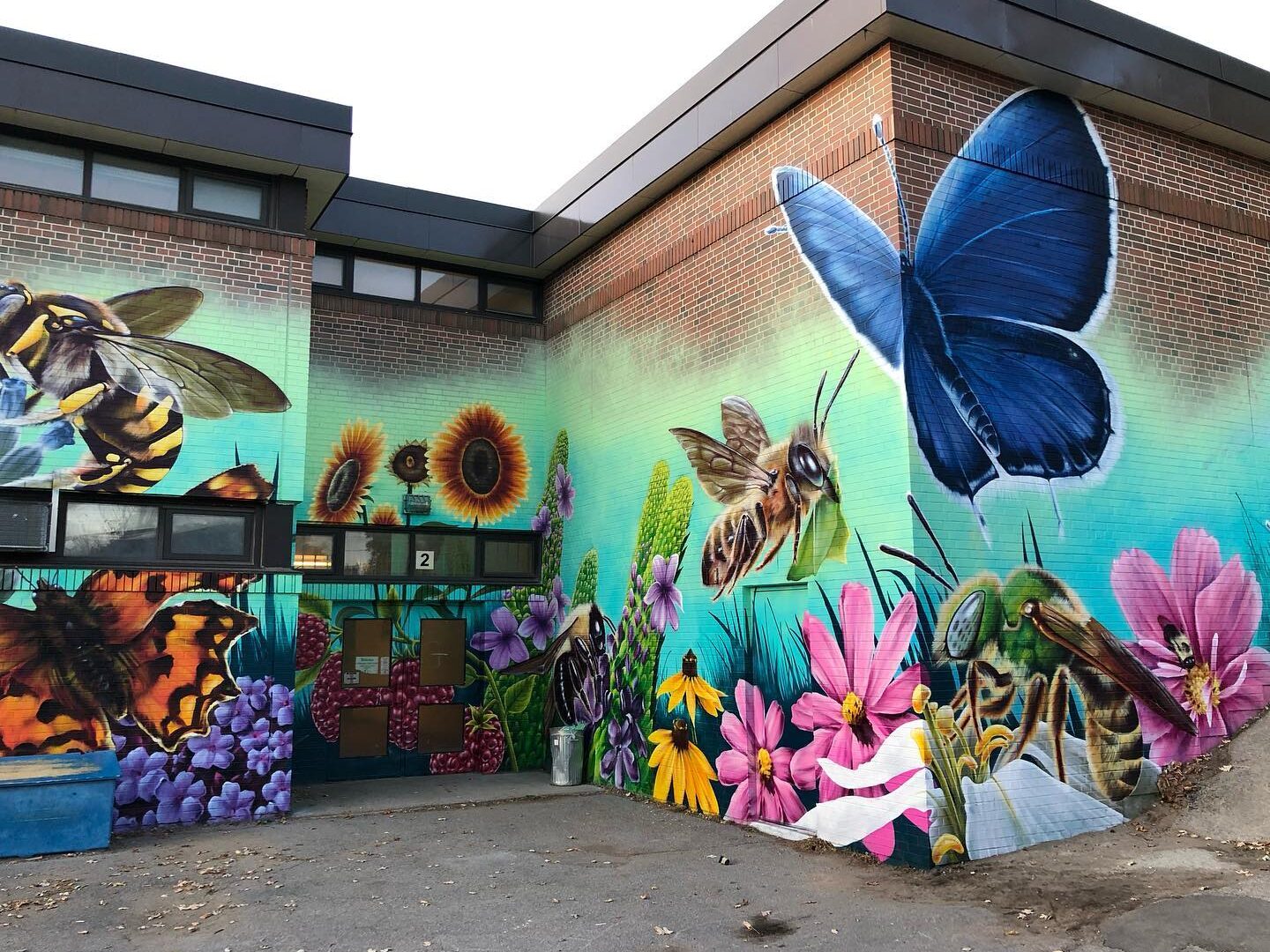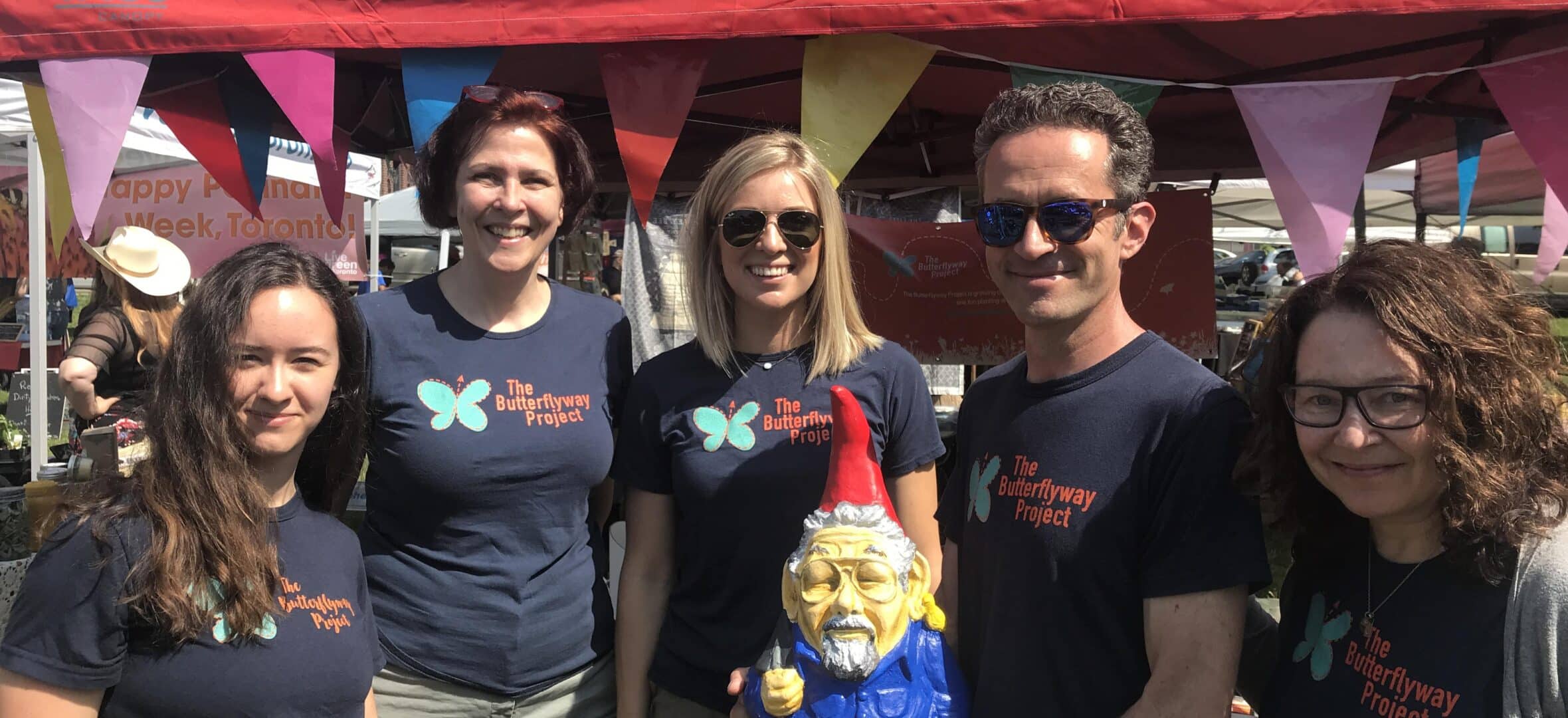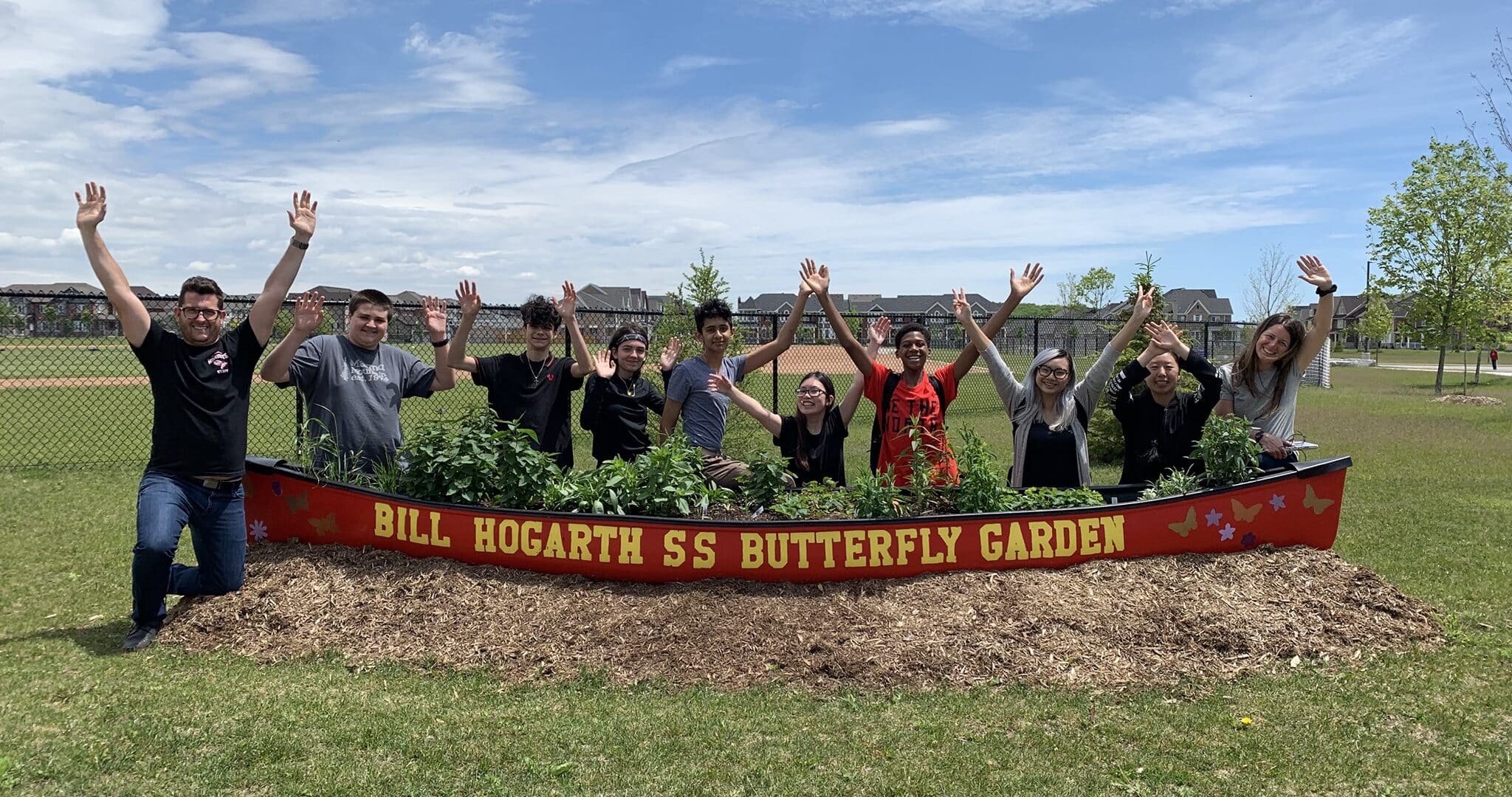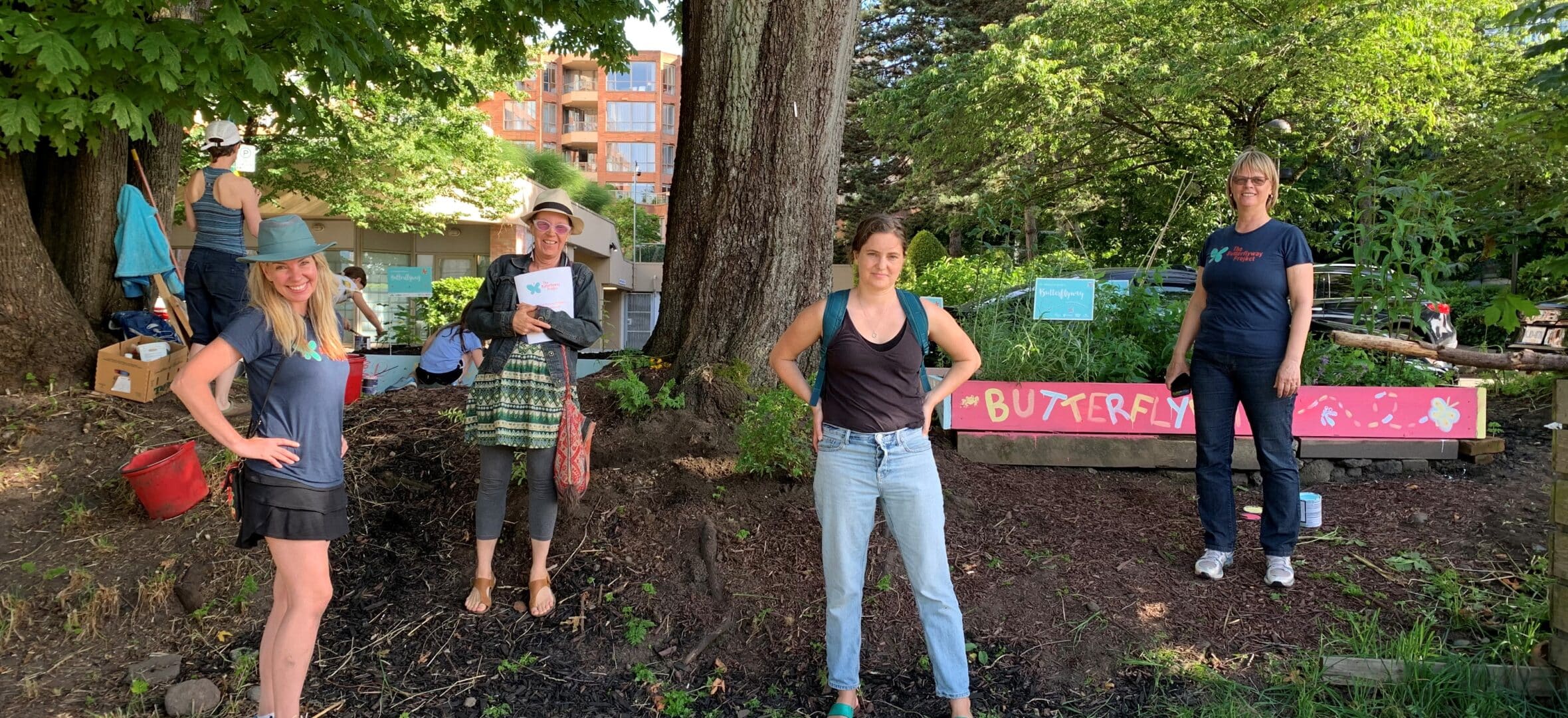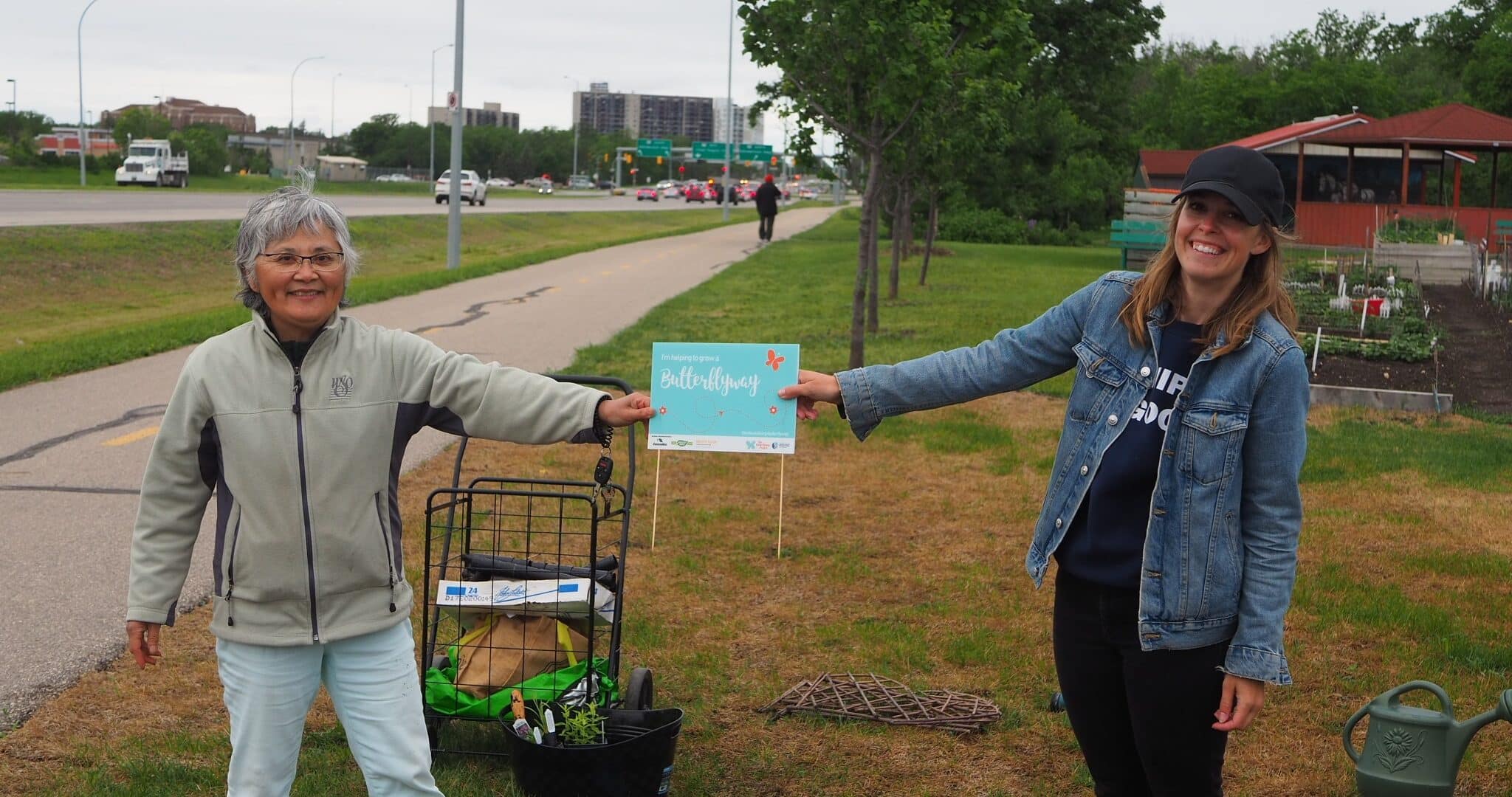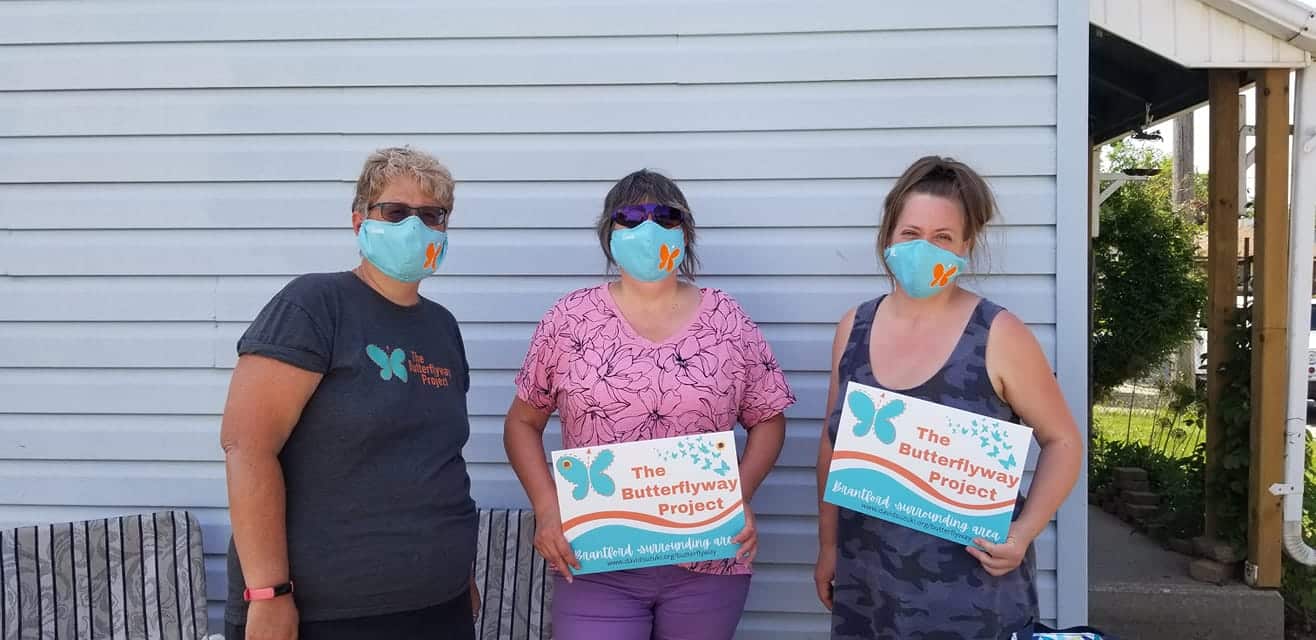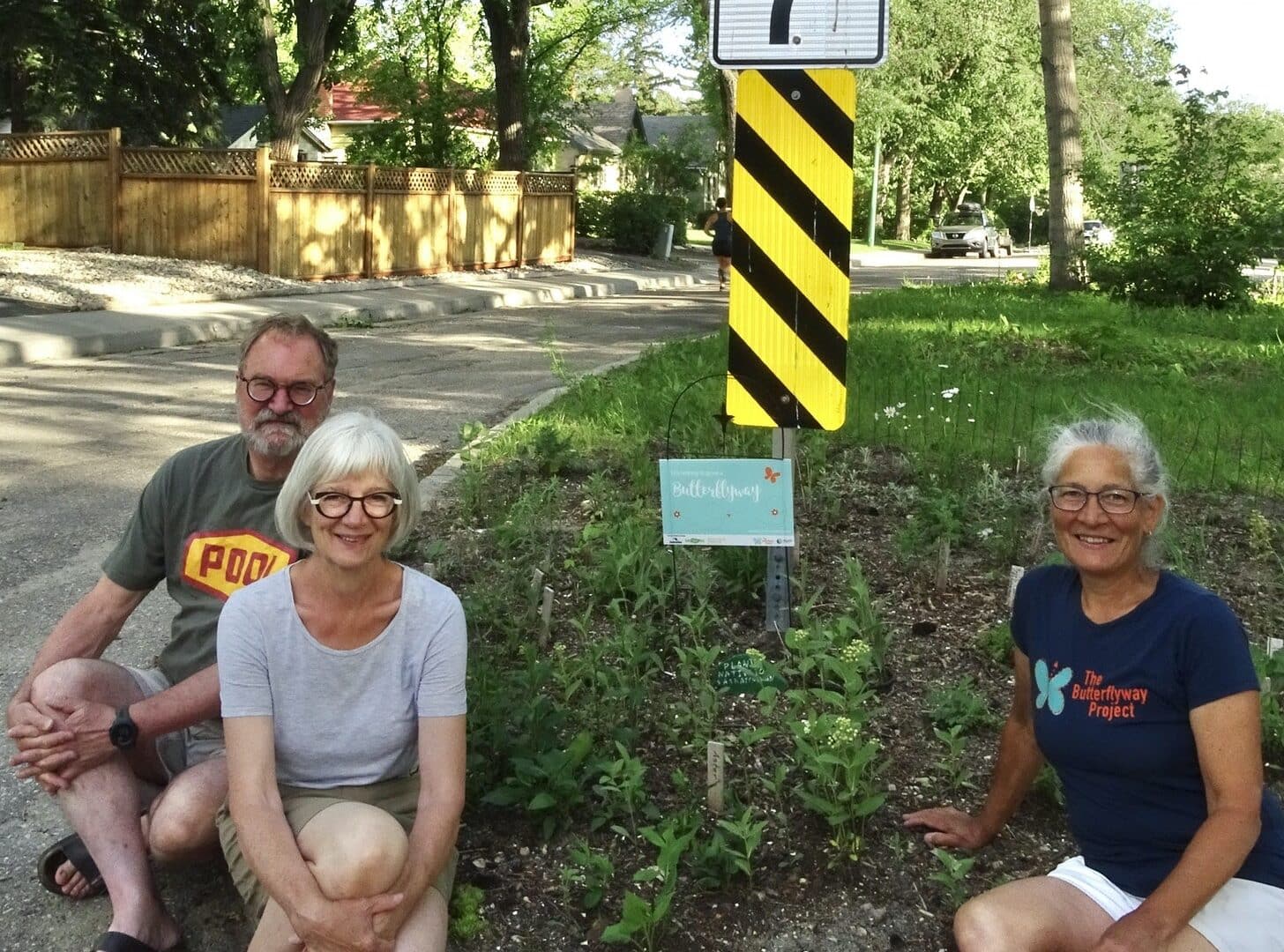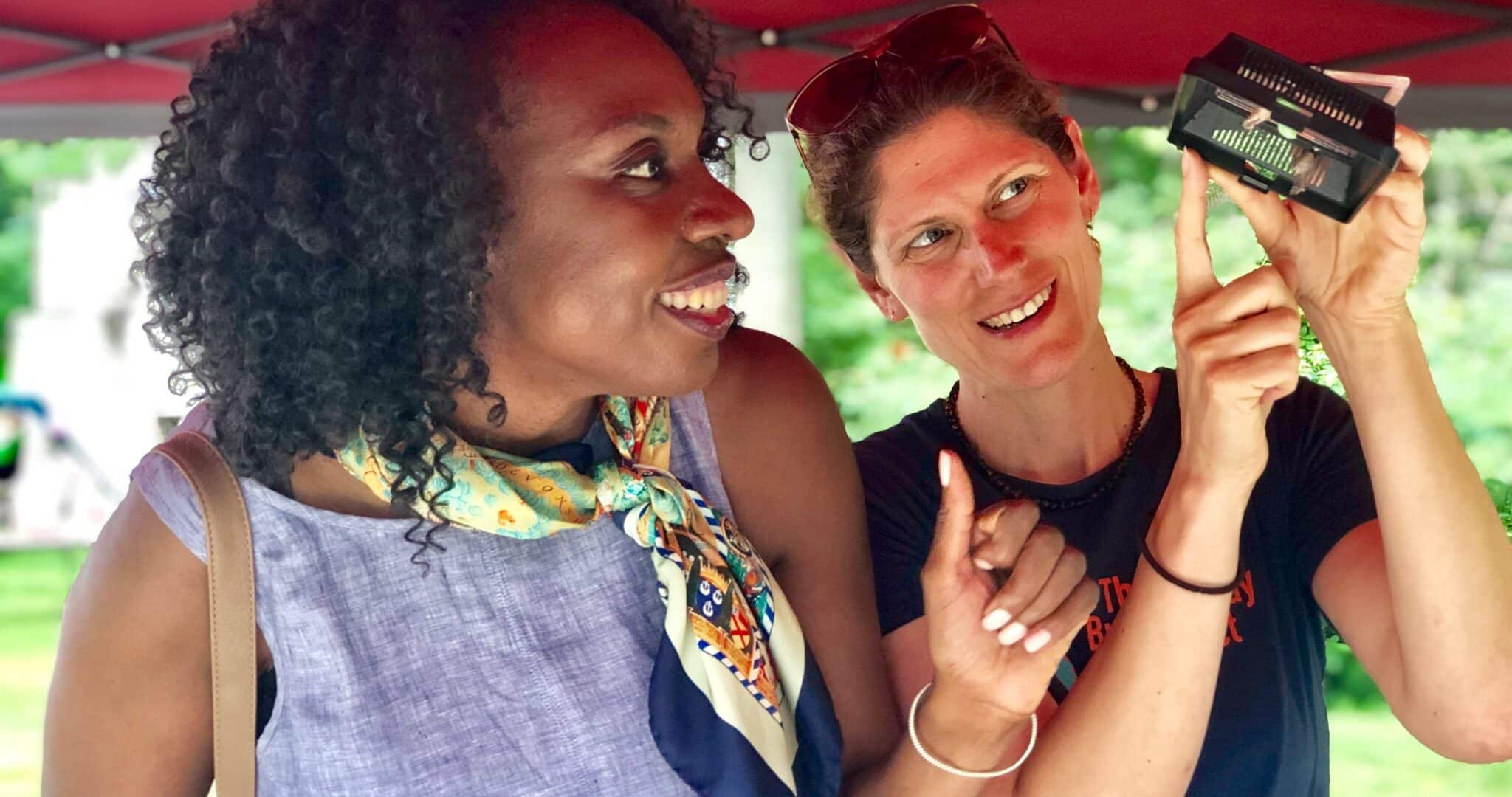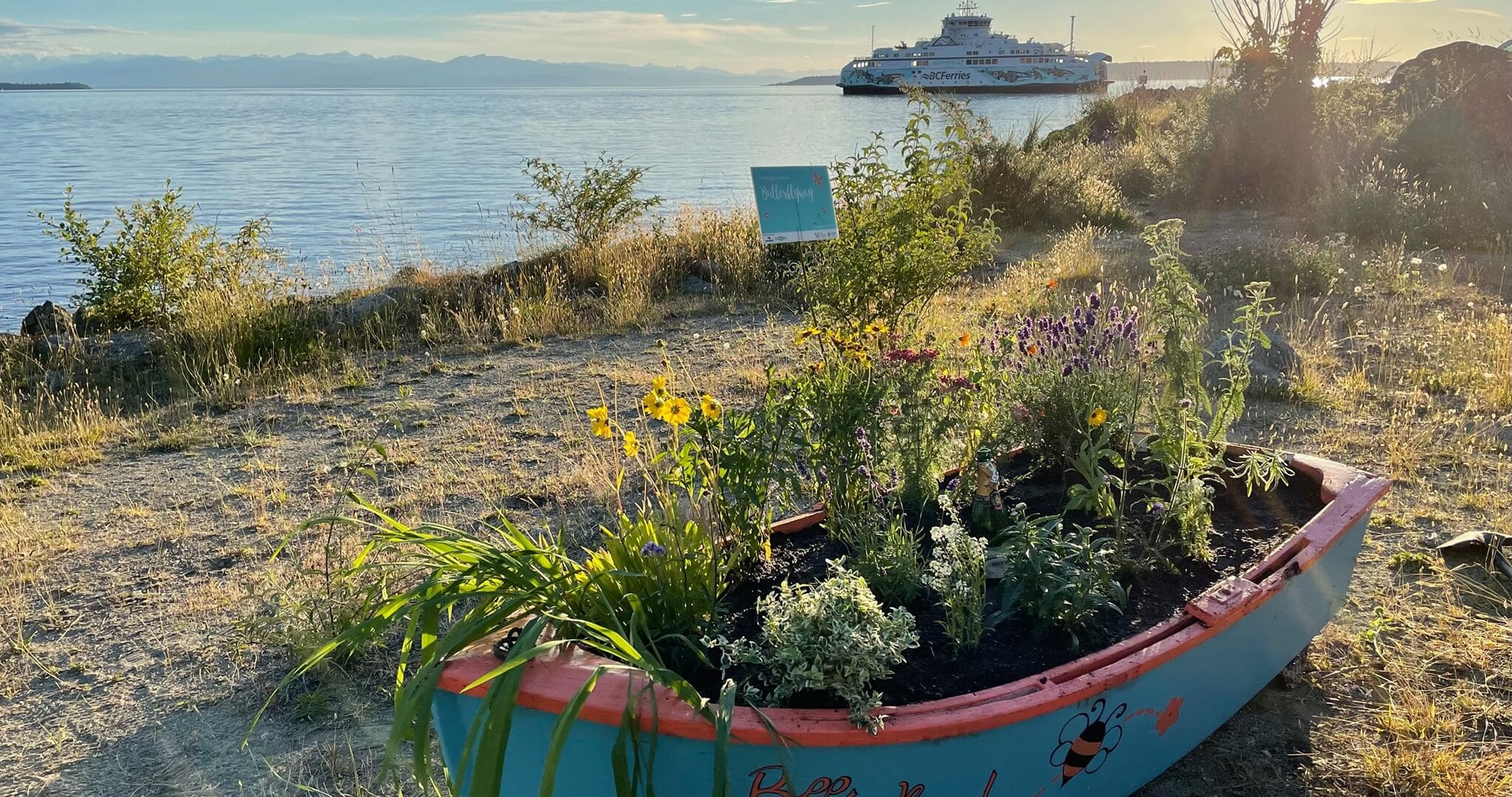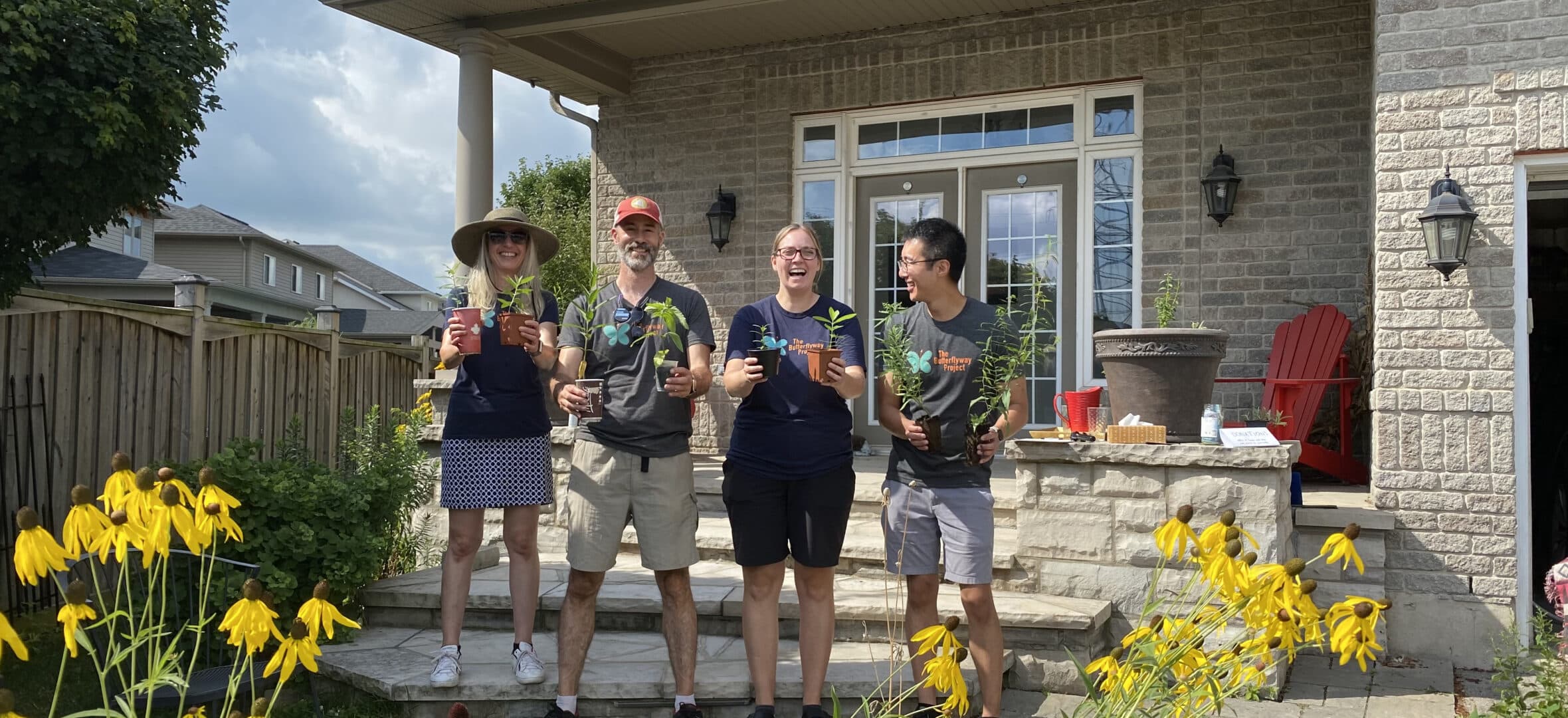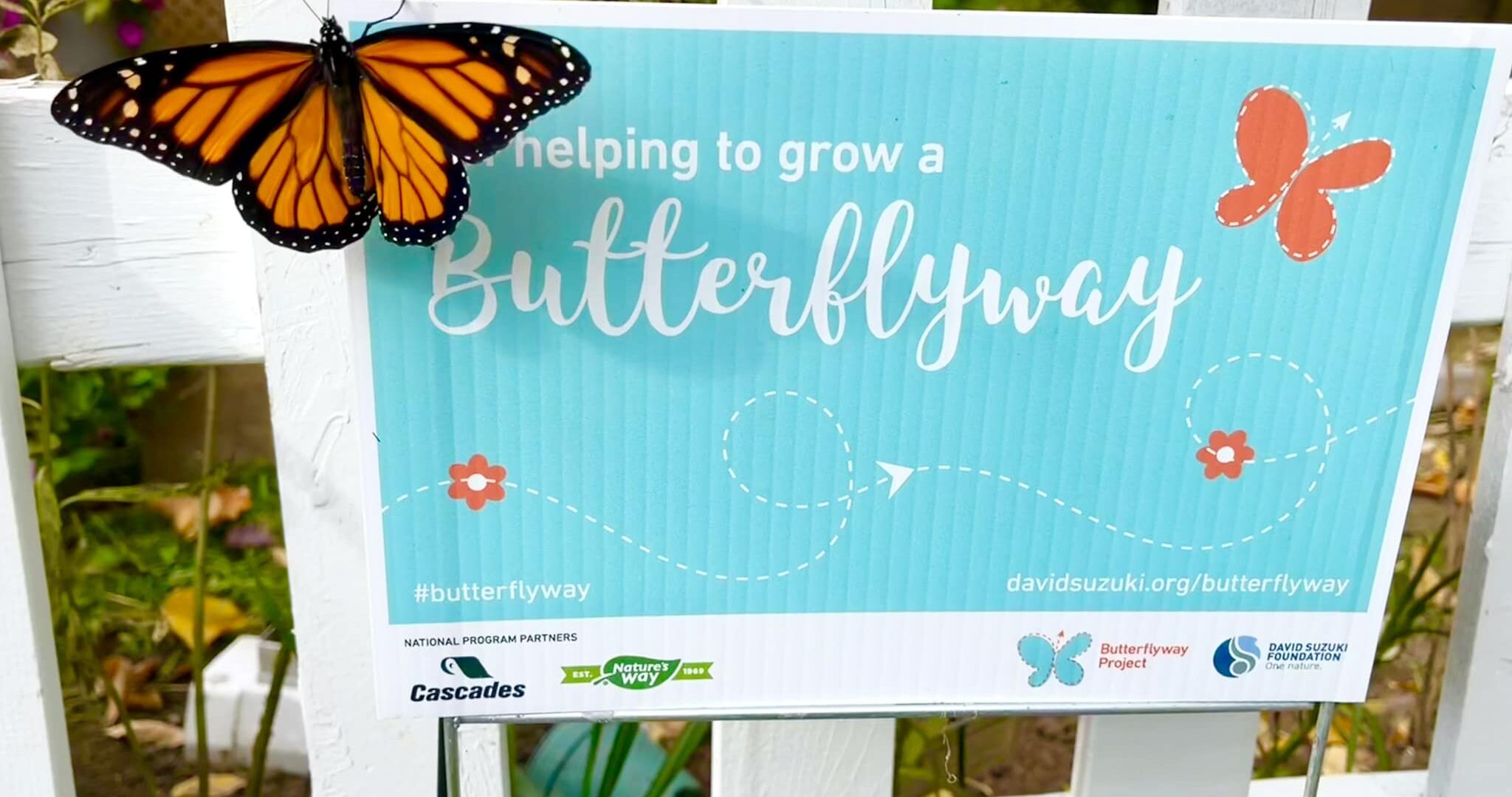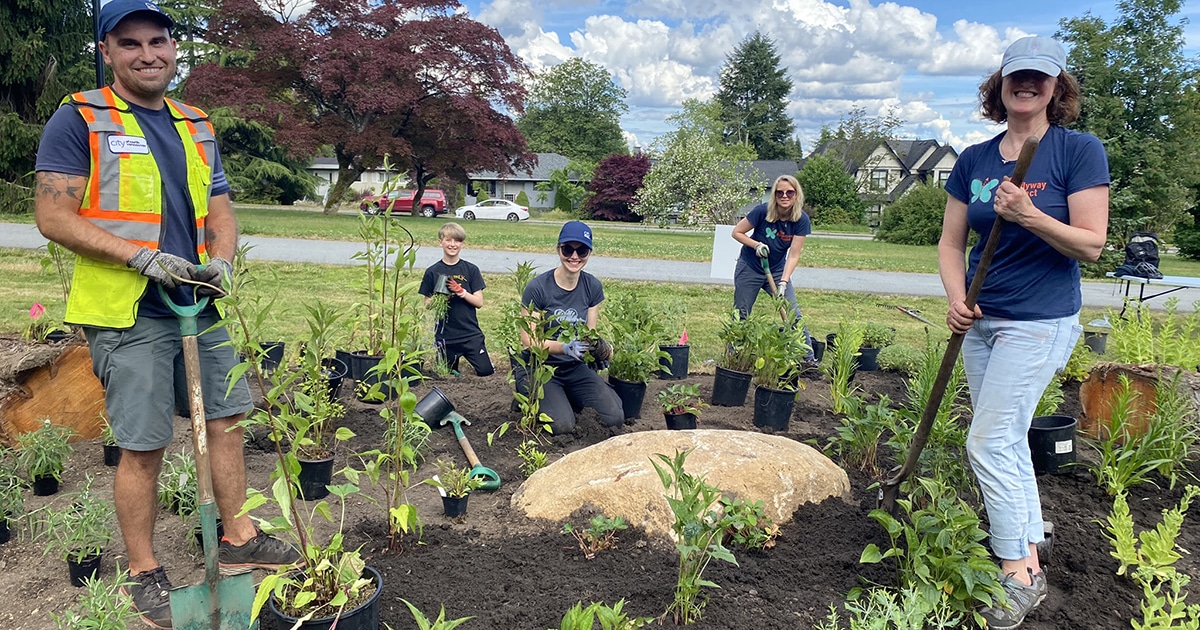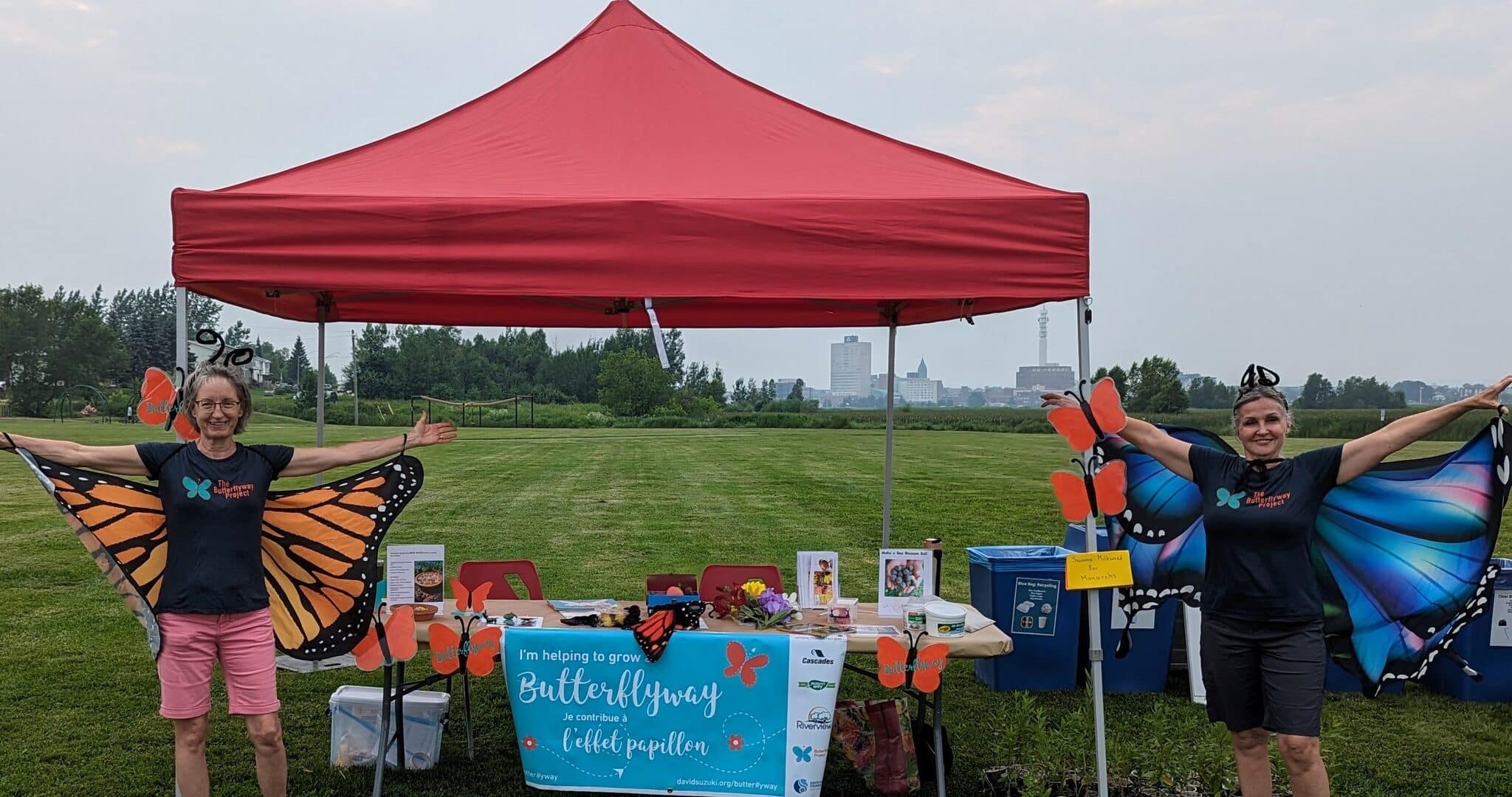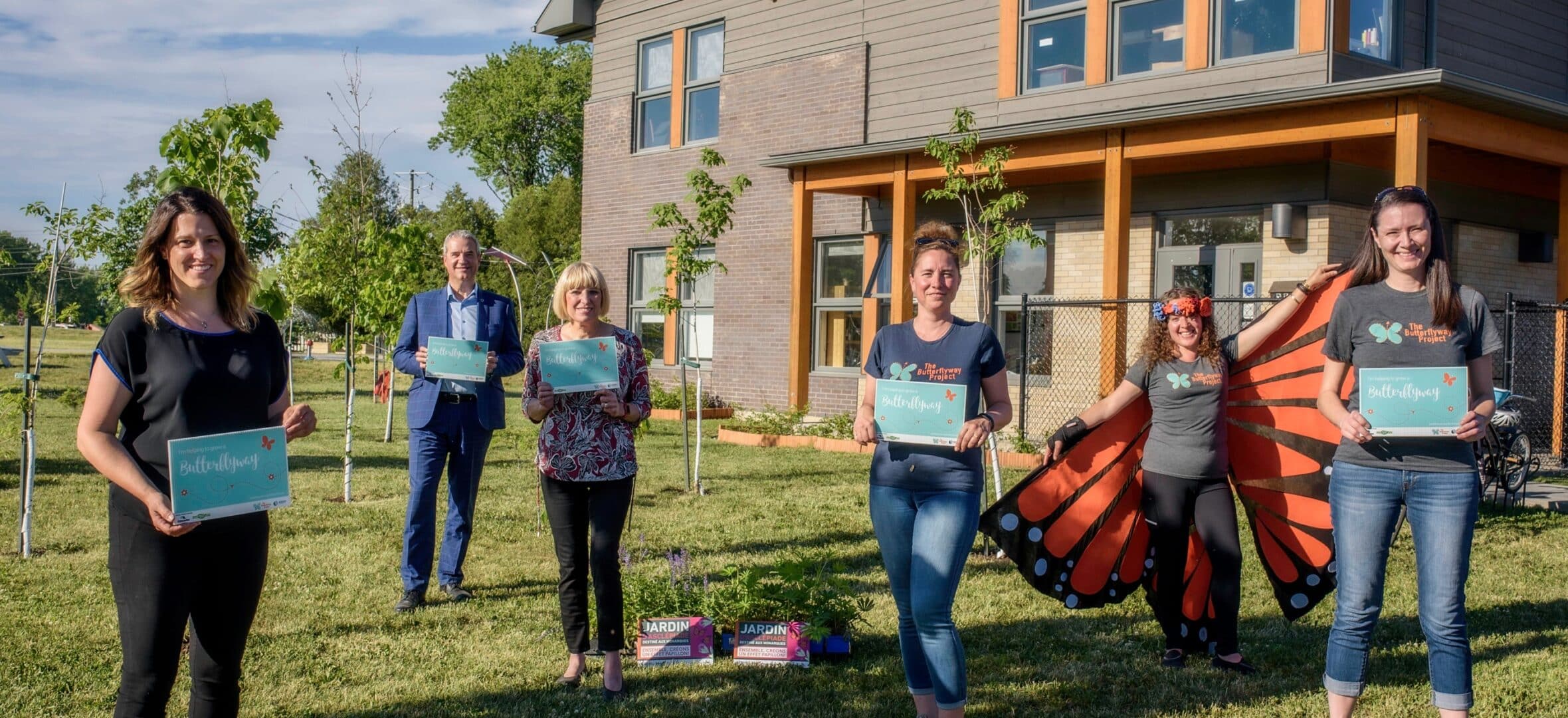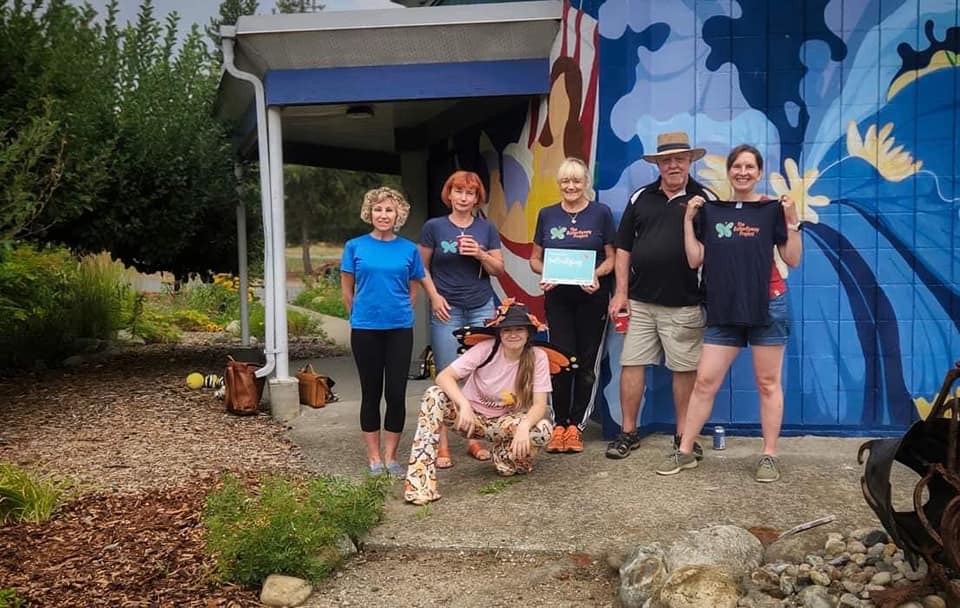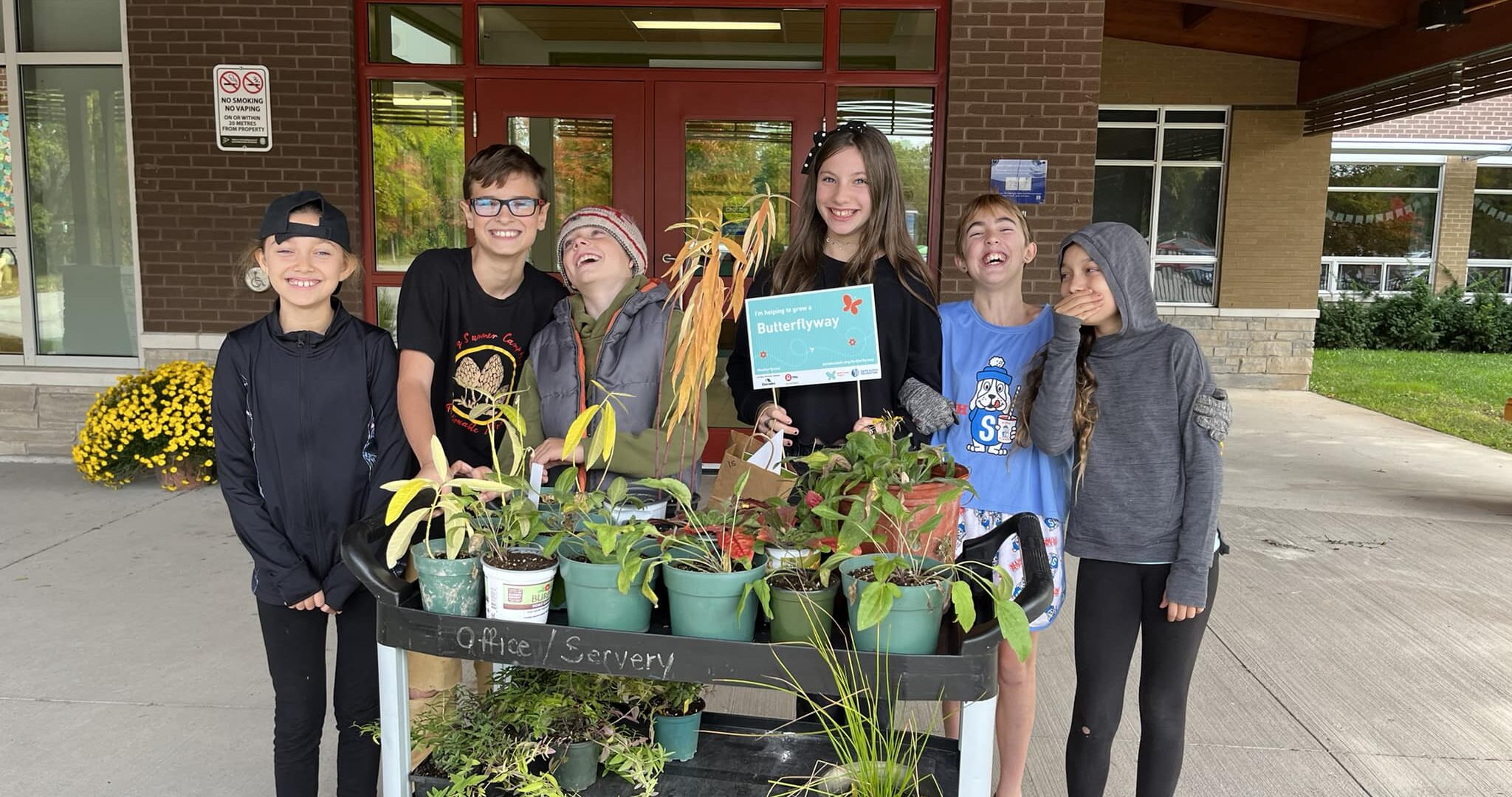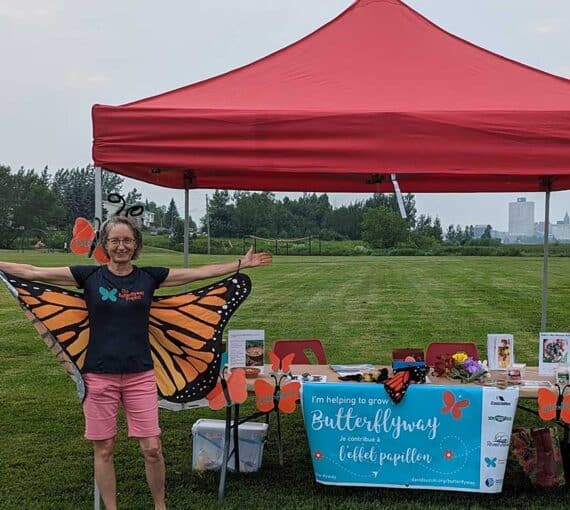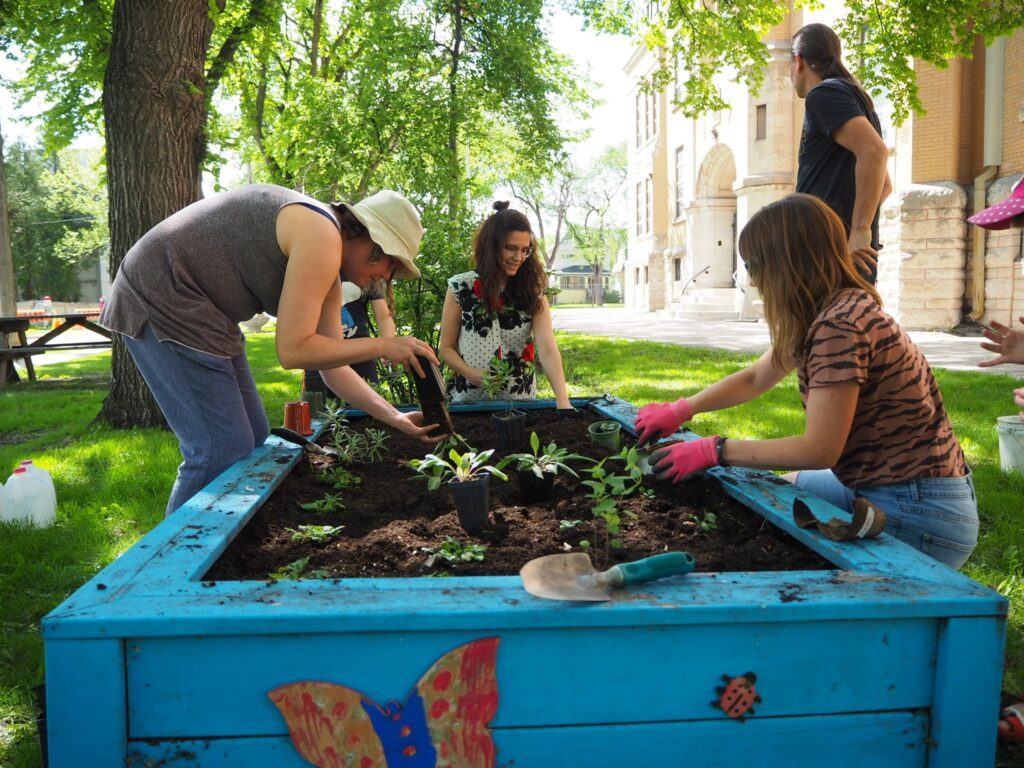
Butterflyway Winnipeg school planting. credit Tara Magee
The Homegrown roots of the Butterflyway Project
The David Suzuki Foundation’s Butterflyway Project began in 2017, but its roots go back to 2013, when a couple dozen residents in Toronto’s downtown west end began reimagining their yards, blocks and neighbourhoods as habitat that sustains local bees and butterflies. These keen volunteers were recruited as part of DSF’s Homegrown National Park pilot project. They adopted the playful title of “Rangers” and the many plantings, workshops and events they organized over the next few years became the model for the Butterflyway Project, and its sister French-language L’effet papillon project.
In 2017, the Butterflyway Project was officially launched nationally, starting in five cities. Volunteer Butterflyway Rangers in each city were recruited and trained. They learned how to engage their communities and create habitat gardens filled with native wildflowers. The aim of each Ranger was to establish a network of at least one dozen habitat gardens throughout their neighbourhood, playfully called a Butterflyway.
Below are highlights from each year of the project, as it evolved from a focus on in-person community leadership training in select communities to an online network with volunteers in hundreds of communities, participating through online webinars, workshops and meetups.
The Butterflyway Project recruits volunteer Rangers each spring, and in 2023 the cohort of active Rangers was about 1,500. The project has received several awards and local, national and international media attention. It has created much-needed habitat on private and public spaces and provided opportunities for friends, neighbours and groups to come together.
For an inspiring look at how Butterflyway Rangers have made butterfly-filled magic happen, despite a global pandemic and the usual challenges with community-led change, we encourage you to check out the “Butterflyway Diaries,” a series of six videos by filmmaker Greg Francis.
You can also check out the Butterflyway Project home page, which provides details about the project, including a map of habitat gardens and Butterflyways created throughout the country.
2013: The Homegrown National Park Project
The David Suzuki Foundation launched the Homegrown National Park Project, a local pilot project based on an idea raised in author Douglas Tallamy’s renowned book Bringing Nature Home. The project was based in Toronto’s downtown west end and encouraged volunteer Homegrown Park Rangers to reimagine their blocks and neighbourhoods as national parks. The Rangers hosted plantings, events and musical parades through city parks. As part of the Homegrown project, Ranger Aiden developed the idea of “canoe gardens,” which later became a cornerstone of the Butterflyway Project. Aiden was looking for a planting project that connected residents to Toronto’s many “lost rivers” buried beneath the city and its extensive ravine system. He landed on the idea of planting native wildflowers in canoes. The core concept of the Butterflyway Project began here: neighbours working together to create native plant gardens that support wild pollinators. Check out video highlights from years one, two and three of this award-winning project.
2014-16: Got Milkweed?
The David Suzuki Foundation ran its “Got milkweed” campaign to encourage gardeners to plant milkweed to support the monarch butterfly population that had plummeted by more than 90 per cent since the 1990s. This led to the distribution of more than 15,000 milkweed and other pollinator-friendly plants, initially in the Toronto area and later throughout the summer breeding grounds of eastern monarchs. In 2016, the popular #knit4monarchs campaign encouraged Canadians to knit chrysalises for monarchs (the campaign launched on April 1).
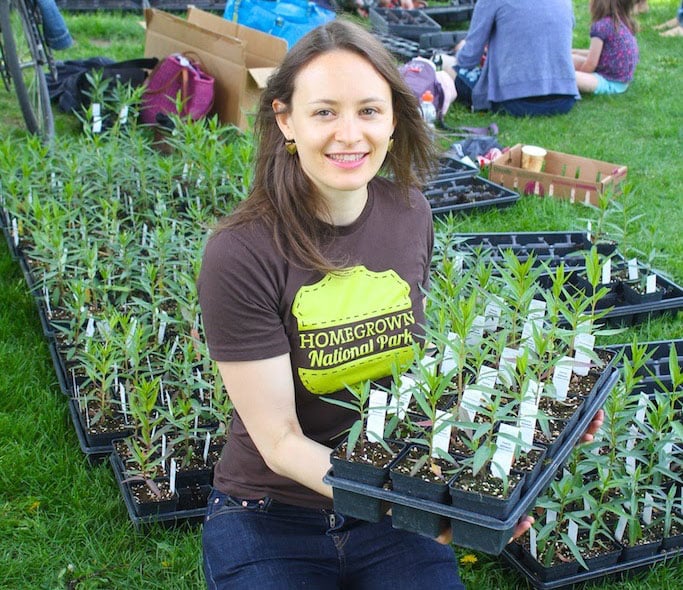
2017: The Butterflyway Project begins
The Butterflyway Project launched! The goal was to recruit and train volunteer Butterflyway Rangers in these five cities: Markham, Toronto, Scarborough, Montreal and Victoria. Rangers were tasked with encouraging friends, neighbours and local groups to help establish butterfly habitat throughout their neighbourhoods. Once a neighbourhood had at least a dozen new butterfly-friendly habitat gardens, the David Suzuki Foundation would formally recognize it as a Butterflyway, including signage and a spot on a national Butterflyway map.
2018: Butterflyway expands to nine cities
Rangers engaged in community outreach and activities, including talks at local schools and libraries, garden and art installations and parades. In Toronto, Rangers installed a dozen wildflower-filled canoes at parks, schools and daycares and led the Butterflyway Lane project, painting butterfly-themed murals on two dozen garage doors, walls and fences in a laneway. Toronto’s Beaches neighbourhood and Richmond, B.C., surpassed the target of a dozen Ranger-led plantings, creating Canada’s first Butterflyways.
- Rangers in Scarborough’s Guildwood neighbourhood hosted native plant sales and giveaways and put on butterfly and bee costumes for a local parade. During Pollinator Week, they planted canoe gardens at schools and churches. Over the season, they planted more than 30 pollinator patches, officially establishing the Guildwood Butterflyway!
- Three Richmond, B.C., schools created schoolyard pollinator gardens and delivered educational activities with their students.
- Street artist Ranger Nick organized a team of local artists to paint 30 butterfly-inspired murals in a west Toronto laneway.
- Residents of a seniors’ complex in Markham’s Swan Lake Village transformed two long-neglected garden beds into pollinator patches, hosted an end-of-season garden party and planted a 17-foot canoe garden at the neighbourhood entrance, with help from city park staff.
- Rangers Stephen and Sally enlisted the help of their neighbours to green the laneway behind their North Vancouver homes. They celebrated the official naming of the Butterflyway Lane with a neighbourhood block party.
- Wildlife photographer Roger joined the Butterflyway Project’s French-language sister program, L’effet papillon, and sowed milkweed seed throughout his neighbourhood in Boucherville, including local golf courses.
2019: Butterflyway spreads; Ville Amie des Monarques begins
By 2019, the Butterflyway and L’effet papillon projects had recruited hundreds of volunteers (as Rangers and Patrouille), who had collectively planted more than 25,000 native wildflowers and created over 400 pollinator-friendly patches in yards, parks and schools throughout the country. Some highlights from 2019:
- In collaboration with the David Suzuki Foundation, the City of Toronto became the largest city in North America to take the Mayors’ Monarch Pledge, as part of its new Pollinator Protection Strategy. The city also awarded 38 grants to community groups for planting activities and distributed more than 20,000 DSF wild bee and native plant guides at 100-plus events throughout the summer.
- Following the launch of Ville amie des monarques, the David Suzuki Foundation’s French-language version of the Mayors’ Monarch Pledge, more than 50 Quebec municipalities committed to restoring monarch butterfly habitat.
- Ranger Josephine and VIA Rail in Vancouver planted a pollinator patch and rooftop wild bee hotels at VIA’s Pacific Central Station.
- The City of Richmond Hill participated in the Butterflyway Project for the first time, distributing Butterflyway plant kits and garden signs to more than 200 households.
- The Dallington mural revitalized the wall of Dallington Public School in North York, Ontario. Painted by Nick Sweetman, and funded by Street Art Toronto’s Partnership Program, with support from David Suzuki Foundation and Dallington Public School, this gorgeous mural portrayed native flowers, bees and other pollinators.
2020: Butterflyway’s pandemic pivot to online networking
Despite the onset of the COVID-19 pandemic in 2020, Rangers still managed to make butterfly-filled magic happen. During that strange and challenging spring, residents from more than 100 communities joined the project as Butterflyway Rangers. The project quickly shifted online, moving from in-person training to Zoom webinars and regional online meetups.
Despite the ever-changing restrictions due to the pandemic, Butterflyway Rangers managed to plant hundreds more pollinator patches. They hosted physically distanced garden tours and online meetings. They promoted their important work on traditional and social media. They brought scores of new people into the movement. And they celebrated five new Butterflyways (in Calgary, Winnipeg, Collingwood, Halton Hills and Ottawa). The project was also recognized by the Canadian Museum of Nature with the 2020 Nature Inspiration Award! Below is a selection of 2020 highlights:
- Ranger Katherine in Halton Hills, Ontario, recruited 51 families to plant hundreds of native wildflowers in parks and at town hall, creating the Halton Hills Butterflyway.
- Rangers Patrick and Melissa knocked on hundreds of doors in Vancouver’s Point Grey neighbourhood, handing out brochures made at a local school and convincing 60 neighbours to plant butterfly gardens.
- In Calgary, Ranger David recruited his neighbourhood association to help establish the Beddington Butterflyway, Alberta’s first official Butterflyway. The group added native wildflowers to main street planters while 30 nearby residents installed habitat gardens in their yards.
- Ranger Dorte and the Cliffcrest Butterflyway team in Scarborough, Ontario, created an impressive website and grew more than 1,000 native wildflowers from seed, which were distributed to neighbours and schools.
- Winnipeg Rangers established more than 30 habitat gardens in schools, private yards and parks in partnership with the Winnipeg Wildflower Project and Manitoba Master Gardeners.
- Ranger Jessica and her crew in Collingwood, Ontario, created a new organization, Pollinate Collingwood, and established a Butterflyway in this charming town.
- Ranger Julie in Markham, Ontario, ordered wildflower kits from a local native plant nursery for a dozen friends and neighbours, and organized safe plant pickups from her porch.
- Ranger Karen in Riverview, New Brunswick, delivered 28 Butterflyway classroom presentations and partnered with classes and a local youth group to plant habitat gardens.
- Representatives from 265 schools in B.C. attended our monthly Butterflyway School webinars.
2021: Butterflyway Project blossoms
In spring 2021, the Butterflyway Project truly blossomed, with more than 1,000 new Rangers. The recruits received the usual training and then got to work establishing neighbourhood partnerships and habitat gardens on public and private land. In all, more than 35,000 wildflowers were planted in 5,000-plus habitat gardens in 2021. New Butterflyways were established in 60 communities, from West Vancouver, B.C., to Winnipeg, Manitoba, and Brantford, Ontario, to Lunenburg County, Nova Scotia.
Below is a selection of 2021 highlights:
- A team of Rangers in Brantford, Ontario, established more than 170 habitat gardens as part of the Brantford and Surrounding Area Butterflyway.
- Ranger Charlene from First South, Nova Scotia, teamed up with her granddaughter to distribute dozens of native plants and seed kits, resulting in more than 60 plantings as part of the Lunenburg County Butterflyway.
- Ranger Sandi encouraged 27 neighbours from her street to plant native wildflowers, creating the Astra Road Butterflyway in Comox, B.C.
- Rangers Carla and Gail in Regina, Saskatchewan, led efforts to plant thousands of wildflowers in yards, schools and the Royal Saskatchewan Museum as part of the Regina Butterflyway.
- Rangers Clara and Jordan-Anne, high school students in Perth and Almonte, Ontario, teamed up to create a dozen new habitat gardens in each of their communities, establishing the Lanark County Butterflyway.
After five years, the Rangers had planted more than 85,000 native wildflowers, including a fleet of wildflower-filled canoe planters from Powell River, B.C., to Chester’s Basin, Nova Scotia.
2022: Butterflyways continue to grow and flourish
Another 300 Rangers were recruited and trained in the sixth year of the Butterflyway Project. Together they planted more than 22,000 native plants and 2,400 native trees and shrubs in 562 gardens and established 16 new Butterflyways. Below is a selection of highlights from 2022:
- In just one growing season, Rangers Yulia, Kati and Judi helped 14 families design and install habitat gardens on their properties, establishing the Georgina Butterflyway. They also spread pollinator and native plant awareness at multiple events and installed a Butterflyway canoe in Georgina, Ontario.
- Ranger Suzan in Sechelt, B.C., raised $2,600 for the Cascades Green Park Butterflyway and assisted with the production of eye-catching print material and garden signs.
- Ranger Ryan in Montreal, Quebec, worked with students at Coronation Elementary School to collect and package seeds from common and butterfly milkweed plants. Packets — with original art on them — will be donated to other schools in the Montreal area as part of the school’s monarch butterfly awareness project.
- Ranger Val worked with a dedicated team of volunteers to care for the Lion’s Bay Indigenous Plant Garden (now Mary Comber Miles Indigenous Plant Garden) in Lion’s Bay, B.C.
- An Indigenous Pollinator Plant Map was created by artist Gracielene Ulu with support and guidance from staff at the Musqueam Indian Band in B.C.’s Lower Mainland. The map depicts native wildflowers planted over the past few years.
2023: Ranger network grows to 1,500; “Butterflyway Diaries” released
An additional 700 Rangers joined the project in 2023, bringing the total number to 1,500 in 300-plus communities. Once again, Rangers spread their joy and knowledge to friends, neighbours and local groups, finding hundreds of new spots to plant and care for native plants. Below is a selection of highlights from 2023:
- Under the passionate leadership of Ranger Olga, the Castlegar Butterflyway in B.C. received the Heritage Conservation Award at the 2023 National Communities in Bloom symposium.
- Ranger Cathern in Dollard-des-Ormeaux, Quebec, provided native plants and guidance to 12 neighbours on her street to form the first Butterflyway on the West Island of Montreal — Montford Butterflyway.
- When developers purchased an ecologically rich parcel of land in Calgary, volunteers with Alberta Plant Rescue salvaged hundreds of plants. Ranger Tamara in nearby Okotoks gratefully accepted some of those plants and created a habitat garden on public land beside her town’s community garden. Pollinators attracted to the newly established native plants will help increase yields for food crops grown in the adjacent community garden.
- Many Butterflyway Rangers advocate for pollinator protection at the municipal level. With their guidance, towns and cities throughout Canada are modifying policies and practices to protect and restore pollinators and their habitats. In June, Ranger Tryna incorporated art and fun into the Town of Comox’s Pollinator Week celebrations.
- Ranger Julie in Markham, Ontario, worked with a local high school to provide native plant and pollinator education and to install and steward pollinator habitat on school property. Students and staff designed a sign to inform passersby of the garden’s purpose and decorated rocks to add to its beauty.
- Ranger Christine in Huron-Kinloss Township, Ontario, secured funding from her municipality and provincial and local horticultural associations to install three habitat gardens on public land, containing more than 200 native wildflowers, grasses and shrubs. Christine is confident that she and her neighbours will plant enough habitat gardens next year to achieve Butterflyway certification and proudly take their place on the national map.
After seven years of Butterfly-filled fun, the David Suzuki Foundation commissioned filmmaker Greg Francis to create a series of short documentary videos. The result is the “Butterflyway Diaries:” a series of six videos featuring Rangers throughout Canada. View them here.
The Butterflyway Project recruits new Rangers each February. Check the Butterflyway Project page or email Colleen at ccirillo@davidsuzuki.org for more information.
